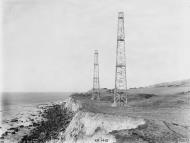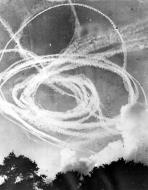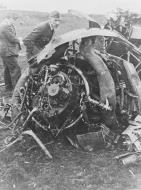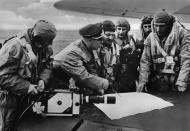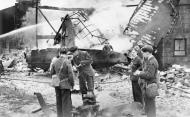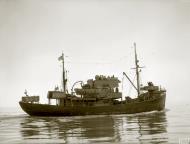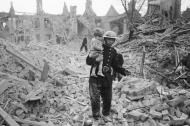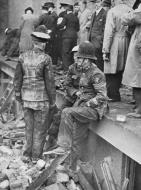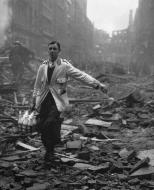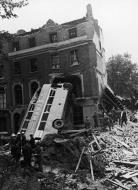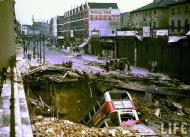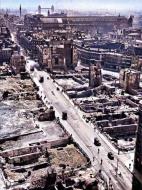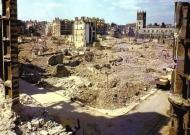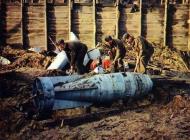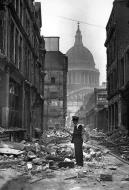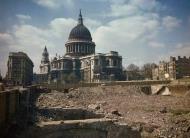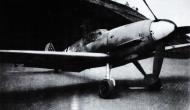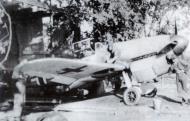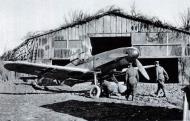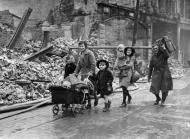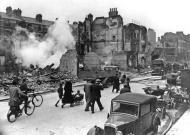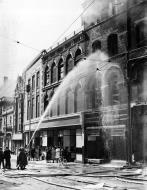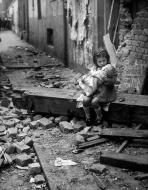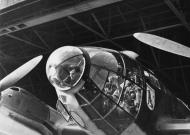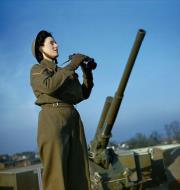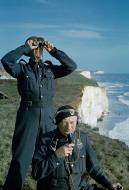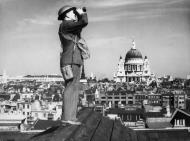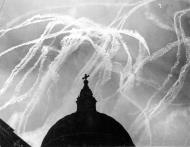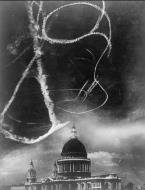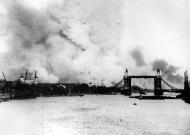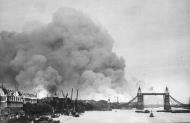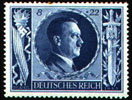Aircraft Strength and Losses
British Air Force Strength During the Battle of Britain Date No Hurricanes No Spitfires 21 August 1940 615 326 30 August 1940 580 287 8 September 1940 530 275 15 September 1940 472 256 2 October 1940 482 281 18 October 1940 512 285
Book Reference: Number of immediately available fighters, according to "The Battle of Britain" by Peter G. Cooksley (Ian Allan Ltd., 1990)
RAF July losses during the Battle of Britain 1940 R.A.F. Fighter Command Aircraft Destroyed Damaged Pilots KIA Pilots MIA Pilots wounded Hurricane 33 destroyed 17 damaged 23 killed 0 missing 11 wounded Spitfire 34 destroyed 24 damaged 25 killed 0 missing 9 wounded Blenheim 4 destroyed 1 damaged 9 killed 0 missing 1 wounded Defiant 6 destroyed 1 damaged 10 killed 0 missing 2 wounded TOTAL: 77 destroyed 43 damaged 67 killed 0 missing 23 wounded
Luftwaffe July losses during the Battle of Britain 1940 Luftwaffe Aircraft Destroyed Damaged Pilots KIA Pilots MIA Pilots wounded Dornier Do 17 39 destroyed 13 damaged 30 killed 74 missing 19 wounded Junkers Ju 87 13 destroyed 11 damaged 10 killed 12 missing 3 wounded Junkers Ju 88 39 destroyed 11 damaged 52 killed 67 missing 11 wounded Heinkel He 111 32 destroyed 3 damaged 52 killed 85 missing 6 wounded Messerschmitt Bf 109 48 destroyed 14 damaged 17 killed 14 missing 13 wounded Messerschmitt Bf 110 18 destroyed 4 damaged 13 killed 17 missing 2 wounded Other 27 destroyed 1 damaged 19 killed 33 missing 15 wounded TOTAL: 216 destroyed 57 damaged 193 killed 302 missing 69 wounded
RAF August losses during the Battle of Britain 1940
RAF August losses during the Battle of Britain 1940 R.A.F. Fighter Command Aircraft Destroyed Damaged Pilots KIA Pilots MIA Pilots wounded Hurricane 211 destroyed 44 damaged 85 killed 1 missing 68 wounded Spitfire 113 destroyed 40 damaged 41 killed 3 missing 38 wounded Blenheim 13 destroyed 10 damaged 6 killed 3 missing 0 wounded Defiant 7 destroyed 3 damaged 7 killed ? missing 4 wounded Beaufighter 0 destroyed 1 damaged 0 killed 0 missing 0 wounded TOTAL: 344 destroyed 98 damaged 139 killed 7 missing 110 wounded
Luftwaffe August losses during the Battle of Britain 1940
Luftwaffe August losses during the Battle of Britain 1940 Luftwaffe Aircraft Destroyed Damaged Pilots KIA Pilots MIA Pilots wounded Dornier Do 17 71 destroyed 30 damaged 70 killed 129 missing 57 wounded Junkers Ju 87 57 destroyed 16 damaged 35 killed 58 missing 19 wounded Junkers Ju 88 89 destroyed 32 damaged 94 killed 182 missing 19 wounded Heinkel He 111 89 destroyed 15 damaged 113 killed 204 missing 35 wounded Messerschmitt Bf 109 217 destroyed 45 damaged 54 killed 91 missing 39 wounded Messerschmitt Bf 110 119 destroyed 40 damaged 80 killed 113 missing 22 wounded Other 27 destroyed 4 damaged 17 killed 27 missing 10 wounded TOTAL: 669 destroyed 182 damaged 463 killed 804 missing 201 wounded
RAF September/October losses during the Battle of Britain 1940
RAF September/October losses during the Battle of Britain 1940 R.A.F. Fighter Command Aircraft Destroyed Damaged Pilots KIA Pilots MIA Pilots wounded Hurricane 294 destroyed 77 damaged 107 killed 2 missing 10 wounded Spitfire 195 destroyed 76 damaged 67 killed 1 missing ? wounded Blenheim 12 destroyed 4 damaged 26 killed 3 missing 55 wounded TOTAL: 501 destroyed 157 damaged 200 killed 6 missing 162 wounded
Luftwaffe September/October losses during the Battle of Britain 1940
Luftwaffe September/October losses during the Battle of Britain 1940 Luftwaffe Aircraft Destroyed Damaged Pilots KIA Pilots MIA Pilots wounded Dornier Do 17 82 destroyed 36 damaged 147 killed 94 missing 50 wounded Junkers Ju 87 1 destroyed 3 damaged 1 killed, ? missing ? wounded Junkers Ju 88 175 destroyed 85 damaged 251 killed 227 missing 74 wounded Heinkel He 111 131 destroyed 78 damaged 203 killed 184 missing 67 wounded Messerschmitt Bf 109 326 destroyed 96 damaged 77 killed 159 missing 36 wounded Messerschmitt Bf 110 124 destroyed 26 damaged 91 killed 109 missing 17 wounded Other 43 destroyed 7 damaged 23 killed 35 missing 16 wounded TOTAL: 882 destroyed 331 damaged 793 killed 808 missing 260 wounded
Spitfire vs. Hurricane during the Battle of Britain
Book Reference: From 'Spitfire Special' by Ted Hooton
Spitfire vs. Hurricane during the Battle of Britain Spitfire vs. Hurricane during the Battle of Britain Spitfire Hurricane Time Period Average Strength 295 461 11th Group 137 243 Average Strength 38% 62% July 1- September 30 German shot down 43% 57% July 1 - September 30 Bf 109 shot down 49% (of all lost) July - August Bf 109 shot down 54% (of all lost) September Combat losses 39% 61% Accident rate 7% 7%
Spitfire vs. Bf 109: 219 to 180 lost respectively.
Hurricane vs. Bf 109: 272 to 153 lost respectively.
Battle of Britain Jul-Aug 1940
In order to establish the necessary conditions for the final conquest of England I intend to intensify air and sea warfare against the English homeland. I therefore order as follows:
The German Air Force is to overpower the English Air Force with all the forces at its command, in the shortest time possible. The attacks are to be directed primarily against flying units, their ground installations and their supply organizations, but also against the aircraft industry, including that manufacturing anti-aircraft equipment.
After achieving temporary or local air superiority the air war is to be continued against ports, in particular against stores of food, and also against stores of provisions in the interior of the country. Attacks on the south coast ports will be made on the smallest scale, in view of our own forthcoming operations.
On the other hand, air attacks on enemy warships and merchant ships may be reduced except where some particularly favorable target happens to present itself; where such attacks would lend additional effectiveness to those mentioned in paragraph 2, or where such attacks are necessary for the training of aircrews for further operations.
The intensified air warfare will be carried out in such a way that the Air Force can at any time be called upon to give adequate support to naval operations against suitable targets. It must also be ready to take part in full force in Operation Sealion.
I reserve to myself the right to decide on terror attacks as measures of reprisal.
The intensification of the air war may begin on or after 5 August. The exact time is to be decided by the Air Force after the completion of preparations and in the light of the weather.
The Navy is authorized to begin the proposed intensified naval war at the same time.
Adolf Hitler
Directive No. 17 for the conduct of Air and Sea Warfare against England August 01, 1940
The British have lost the war !!!
"The British have lost the war, but they don't know it; one must give them time and they will come round."
Adolf Hitler commenting to General Alfred Jodi following the Franco-German Armistice in June 1940
June 1940 and Germany was riding the crest of a wave. Virtually everything in the campaigns against France and the Low Countries had gone according to plan. In a period of less than two months much of Western Europe had been brought under German occupation and control. All that now stood between Germany and complete domination of the whole area was Great Britain. A victorious Adolf Hitler, although preoccupied with his thoughts on the conquest of Russia, now looked for a rapid and favorable decision in the war against Britain and retained the hope that a negotiated settlement with her could be reached. However, as it became increasingly clear that no such agreement would be forthcoming, his attention began to focus on the forceful subjugation of the island kingdom, including if necessary, its invasion and occupation.
With no indication that a peaceful settlement of any kind would be reached, the OKW was now given the task of preparing for and, if necessary, achieving the successful invasion of Great Britain. For an invasion to succeed, it would have to take place within a three-month period of anticipated good weather under complete air superiority, and before the onset of the autumnal channel gales.
"The near future will show whether Britain will do the reasonable thing in the light of our victories or will try to carryon the war alone. In the latter case the war will involve Britain's destruction and may last a long time."
General Franz Halder, diary entry 22 June 1940.
With their record of military successes, it is not surprising that both Hitler and the OKW General Staff retained a purely continental view of carrying out such an invasion; an operation which they likened to a powerful river crossing on a broad front with the Luftwaffe taking the place of artillery. It was believed that the well-proven Blitzkrieg tactic, i.e. destruction of the opposing air force, followed by the rapid advance of the German Army with its powerful and direct air-support would also succeed against Great Britain. There was, however, one major difference - the Royal Air Force; it was the single most powerful air force yet encountered by the Luftwaffe. Bearing this and their recent successes against other European air forces in mind, the Oberkommando der Luftwaffe estimated that its complete destruction would take longer than the 12 to 48 hours taken to defeat each of the air forces fought previously. Furthermore, it was known that the British would put up a fierce and determined fight in defence of their homeland. Based on these calculations, the OKL predicted that, in the event that an invasion should take place, a period of four days would be needed to secure total air superiority in the immediate invasion area. It further anticipated that in the wake of a successful invasion, the complete destruction of the Royal Air Force could be achieved within a period of no more than three weeks. The key to the successful completion of any invasion, however, would be German supremacy in the air.
"The landing in England, prepared down to the smallest detail, could not be attempted before the British air arm was completely beaten".
General Alfred Jodi, Munchen, November 1945
Studie Blau' (Case Blue)
In 1940 the Luftwaffe was undoubtedly the most powerful air force in the world but the German intelligence system was disorganised and inefficient. It was against this background that on, 1 January 1938 Abteilung 5, the intelligence section of the Luftwaffe General Staff was formed, tasked with the collection of information on foreign air forces and the preparation of target information for use in any future air war. Command of Abteilung 5 as Chief IC (Intelligence) was given to Major Joseph Schmid who, although a shrewd and ambitious man, had no foreign language skills and was not a pilot. It is perhaps significant of the value placed on intelligence by the Luftwaffe that the appointment required only the rank of Major. For the last few months of 1938 and the first half of 1939, Schmid and members of Abteilung 5 carried out studies on Poland, Russia and England. While the preliminary work on England was being undertaken, an order was received from the Commander in Chief of the Luftwaffe, Hermann Goring, demanding a high priority study of the air and industrial armaments capability of Great Britain. This subject was considered so important that a study committee was formed with Erhard Milch, Ernst Udet and Hans Jeschonnek as permanent members and Schmid as chairman. The result of this study was a full report on Britain that appeared in July 1939 under the title of 'Studie Blau' (Case Blue). For most of the Second World War, this document would provide the basic reference material on which attacks against England were planned.
While realizing that, militarily, England was an enemy to be respected, Schmid had already begun to under-estimate the efficiency and potential of the RAF. During the latter part of 1939, he devoted most of his time to formulating an offensive plan against England which would severely damage her, regardless of the outcome of the campaign against France. In late November 1939, this document was issued under the title 'Proposal for the Conduct of Air Warfare against Great Britain'. Although far-sighted, it was probably the last study in which Schmid was able to make an objective and accurate forecast concerning Britain. While the theme of this study concentrated on the strangulation of Britain's ocean supply lines and harbor facilities he neglected to take into account two very important factors; the potential danger of the British radar chain and the lack of German maritime and torpedo bombers.
As the time passed, Schmid concentrated on 'Studie Blau' and the mass of information captured by Germany with the fall of France. On 16 July 1940, having compiled and studied all of the available background information, Schmid completed an overall survey on the qualities of the RAF and on which the coming offensive would be based. Aside from containing numerous misleading and inaccurate statements regarding the military and operational capabilities of the RAF, the study omitted any reference whatsoever to the closely-knit British defence system with its radar stations, operations rooms and complex HF and VHF radio network. In conclusion, Schmid stated that "The Luftwaffe is in a position to go over to decisive daylight operations owing to the inadequate air defences of the island."
Enigma Ultra decrypts and the Battle of Britain
In addition to an established defensive warning system, Britain had one other measure that she could employ in her defence - decoded transcripts of German signals traffic sent by the Enigma coding system. First coming into use during the summer of 1940, the 'Ultra decrypts' as they became known, were useful to the planning of RAF strategy but did not offer the scope of material that would become available as the war progressed. As the Luftflotten proceeded to follow Goring's orders, they found defending RAF fighters were nearly always there to meet them, in the right place, and, whenever possible, in significant numbers. Directed not only by the chain of RDF stations and radio communications, they were also guided by information obtained from the contents of decoded signals intercepted from the flow of Enigma traffic between the OKL and Luftwaffe units. This access to German planning strategy allowed the head of RAF Fighter Command, Air Chief Marshal Dowding and his Group Commanders, to apportion their resources accordingly and stem the Luftwaffe onslaught.
Although the decrypts of the Luftwaffe's intentions clearly had an impact on the final outcome of the Battle, exactly how far they contributed to the ultimate victory of the RAF during 1940 remains an ongoing topic of discussion amongst historians to this day.
Preparation: July 1940
Until the end of the campaign in the West, the air war against Great Britain had been carried out on a limited scale, being confined for the most part to mine-laying, attacks against merchant and naval shipping and attacks on targets of a secondary nature. Then in June 1940, with the countries of Western Europe under German occupation, the circumstances changed. The airfields and installations of occupied Europe provided every facility to allow the full strength of the Luftwaffe to be strategically deployed against Britain. However, despite being in such an advantageous position, the Luftwaffe was faced with a formidable task, one that begged the question; "If Britain fought on, could air power alone defeat her?
In supporting the Army in its march across Europe, the Luftwaffe had played an important and decisive role in the tactic of Blitzkrieg. There it had been used to open each offensive by destroying the opposing air force in the air or on the ground before joining with the rapid advance of the Army to give powerful and direct air-support wherever needed. But in the mid-summer of 1940, for the first time in its history, the Luftwaffe would embark on a course of action that had no precedent in the history of modern warfare. Wholly independent of operations by the remainder of the Wehrmacht, it was to carry out an aerial offensive aimed at decisively defeating an opposing air force and forcing the capitulation of an entire nation.
At this period, total air war was known only as a theoretical conception. Until then no attempts had ever been made to wage war solely by use of air power, independently of the Army or Navy, in order to break the fighting spirit of an enemy equipped with modern arms.
The following were the strategic missions imposed on the Luftwaffe:
a) the blockade of Britain (in conjunction with the Navy) by air attacks on shipping and ports;
b) softening-up for the invasion; offensive aimed at gaining air superiority;
c) forcing Britain to surrender by waging total air war against her.Comment by General Adolf Galland on the role of the Luftwaffe in 1940 in a post-war appraisal of the Battle of Britain, Air Historical Branch Translation VII/121, 1953, p.11
The necessary regrouping of Luftwaffe forces in preparation for the assault on England showed little change from those used in the Battle for France. Luftflotten 2 and 3 had simply extended their areas westwards into France with a common boundary at the mouth of the River Seine on the Channel coast. This boundary was then extended northwards through the centre of England to give each Luftflotte its own sphere of operations. Luftflotte 2 under the command of the competent and newly promoted Generalfeldmarschall Albert Kesselring, would operate to the east of this boundary while Luftflotte 3, under Generalfeldmarschall Hugo Sperrle, similarly recently promoted, would operate to the west. The subordinated Fliegerkorps of each Luftflotte remained unchanged but for one exception; Fliegerkorps /I and IV were interchanged so that Fliegerkorps IV, based in western France with units specialising in the anti-shipping role, would be better placed to operate over the shipping lanes of the Irish Sea and Western Approaches. The Norwegian based Luftflotte 5, under Generaloberst Hans-Jurgen Stumpff, would not play any major role in the early stages of the attack against Britain. However, its bombers and twin-engined fighters would provide valuable widespread anti-shipping and diversionary attacks against Northern England and Scotland which would force the RAF to keep fighter defences in the north, so weakening the aerial defences in the south.
A second change introduced with this regrouping assembled the single and twin-engined fighter units from the Fliegerkorps of each Luftflotten into two tactical fighter commands. Known as 'Jagdfuhrer' or 'Jafus' with Jafu 2 under Luftflotte 2 and Jafu 3 under Luftflotte 3, these commands were able to retain a measure of independence in the planning of escort duties and fighter sweeps within the operational setting of their respective Luftflotte. While similar in purpose to the Fighter Groups of the RAF that they were to face in the coming battles, they lacked any means or procedure for plotting the position of enemy aircraft, nor had they any method for controlling their own fighters once airborne. Therefore, although performing the function of an operational command; aerial operations were flown without any guidance or additional direction from their ground facilities. This disadvantage would undermine the whole effort of the Luftwaffe Fighter Arm.
The Luftwaffe Plan of Campaign July 1940
Within the overall framework of the OKW's plans for the invasion of Great Britain, the two major tasks assigned to the Luftwaffe appeared straight-forward enough: neutralisation of the RAF as a fighting force and the suppression of sea-borne supplies to Britain by attacks on its ports and shipping. Luftflotten 2 and 3 were to achieve and maintain air superiority over southern and south-eastern England while Luftflotte 5 carried out diversionary attacks against Scotland and northern England to prevent some of the defending fighter squadrons from reinforcing those in the south.
Orders issued by the OKL operations staff to the three Luftflotten made it clear how these objectives would be met. In the first phase which would continue until the end of the first week in August, the Luftwaffe would attack British defences and carry out attacks against merchant and naval shipping, port facilities and selected industrial targets. This would be followed by an intensified second phase; a six week major aerial offensive designed to destroy the infrastructure and defensive capabilities of the RAF, neutralise the British coastal defences, wear down initial resistance, destroy military reserves behind the main defences and protect the build-up of invasion forces. This second phase would begin on a day given the code name Adler Tag - 'Eagle Day', the date of which would be determined by the first period of fine weather following the end of the initial phase. The prime objective, however, would be the neutralisation of the RAF and its ground organisation by attacking its aircraft, especially fighters, on the ground and in the air, and attacks against bases and supply installations and against its supporting industry. Once this second phase had been completed in southern England, the offensive, in keeping with the intended OKW plan, would then be extended northwards in a series of stages.
During the third week of July, the Luftwaffe was ordered to a state of full readiness and the final details and operational orders were worked out. The unit strength returns from the three Luftflotten for this week gave them a total of 2,076 serviceable aircraft of which 656 were single-engined fighters and 168 twin-engined fighters. Ranged against them was a total of 1,519 serviceable RAF aircraft of which 606 were single-engined fighters and 101 twin-engined fighters. The stage was now set for a battle that had no precedent in the history of warfare; the greatest and probably most decisive aerial battle ever fought.
1.20 July 1940
In the broadest sense - and with some justification - it may be said that the Battle of Britain began on 30 June 1940. On that day, German forces had landed unopposed on the island of Guernsey, the largest of the four Channel Islands. Within the next 24 hours, this small group of islands, all sovereign territory of Great Britain, would be under full German control. By the end of July, an operational Luftwaffe landing ground had been established at the airfield on Guernsey and would be the only airfield on British soil to be used by the Luftwaffe during the Second World War. It would be from here that elements of JG27 and a Staffel of Major Freiherrvon Maltzahn's II/JG53 would operate against Britain's defenders during the coming battle.
Throughout the first 20 days of July, daylight aerial activity over Britain was generally confined to bombing attacks on coastal shipping, port facilities and industrial targets, while 'freie Jagd' operations were flown by the fighters of JafD 2 and 3. No fighters were lost in combat until the 4th, when two Bf-109s, from III/JG27 and 4.(J)/LG 2, were claimed by P /0 Smythe of 32Sqn during a mission over the English coast. Of the two claimed, that from JG27, although damaged, succeeded in returning to Thewille, but the machine from LG 2 was seen to crash into the sea, the pilot being listed as missing. On the 5th, an aircraft from 2/JG51 was slightly damaged in combat with Spitfires of 64Sqn. No combat losses occurred on the 6th but during the evening of the 7th a 'Freiejagd' by JG27 resulted in the downing of three Spitfires of 64Sqn. Although two victories were claimed by RAF pilots, the only Bf-109E listed as damaged that day, was an aircraft of III/JG27 which was severely damaged in a take-off accident at Theville.
On the 8th, increased activity over Channel convoys resulted in the loss of three fighters including the first Bf-109 E to come down on British soil. At 15.45 hrs this aircraft, 'White 4', an E-3 of 4/JG51 flown by Lt. Johann B6hm, force landed at Bladbean Hill, Elham, Kent after being damaged by a Spitfire of 74Sqn. This was followed at 19.30 hrs by the second Bf-109 to crash in Britain, this time an aircraft from 3.(J)/LG2, which was shot down by 54Sqn and crashed near Sandwich, Kent. The pilot, Lt. Albert Striberny, was captured after baling out. An aircraft from III/JG51 was also lost in action on this date with a fourth from II/JG51 being damaged in combat with 610Sqn. The 9th again saw increased fighter activity over the Thames Estuary and Channel but, despite RAF claims for two Bf-109s shot down, only one, from II/JG51, was recorded as being lost.
"...he saw me almost immediately and rolled out of his turn towards me so that a head-on attack became inevitable. Using both hands on the control column to steady the aircraft and thus keep my aim steady, I peered through the reflector sight at the rapidly closing enemy aircraft. We opened fire together, and immediately a hail of lead thudded into my Spitfire. One moment the Messerschmitt was a clearly defined shape, its wingspan nicely enclosed within the circle of my reflector sight, and the next it was on top of me, a terrifying blur which blotted out the sky ahead. Then we hit."
F/O. A.I. Deere, 54Sqn, commenting on his head-on collision with a Bf-109 of II/JG51 during a dogfight with the fighter escort for a He-59 of Seenotflugkommando 1 during the evening of 9 July 1940.
On 10 July, the major fighter activity of the day took place over the west-bound convoy' Bread' in the English Channel. There were no German fighter losses during the morning's fighting but a JG51 aircraft was claimed as slightly damaged by a Spitfire from 74Sqn. In the afternoon battles above the convoy, one Bf-109 from 5/JG51 was lost while a further two from 7/JG51 were damaged severely enough to result in forced landings in France, both pilots escaping serious injury.
"The whole cockpit stank of burnt insulation but I managed to stretch my glide to the coast, then made a belly-landing close to Cherbourg. As I jumped out the machine was on fire, and within seconds ammunition and fuel went up with a bang!"
Ofw. Arthur Dau, 7/JG51, commenting on what happened after being hit by fire from a Hurricane flown by sgt. A.G. Page, 56Sqn during combat over the convoy 'Bread' 10 July 1940
"Suddenly the sky was full of British fighters. Today we were going to be in for a tough time."
Hptm. Hannes Traut/oft, III/JG51, commenting on the action over the British convoy 'Bread' 10 July 1940
On the 11th, 12th and 13th, attacks on Channel convoys continued resulting in one Bf-109 of 9/JG51 being shot down near Dover on the evening of the 13th. On the 14th, battles again developed over Channel convoys resulting in the loss of one aircraft from 8/JG3 and a second from the same Staffel returning to France severely damaged. Although skirmishes continued for the next four days, operations were hampered by bad weather and no further fighters were lost in combat until the 18th when a Bf-109 of II/JG2 was lost to unspecified reasons during an operational sortie. On the 19th, the day on which Hitler would make his' Last Appeal to Reason' speech, improving weather resulted in increased fighter activity off Dover. In the early afternoon, the Defiants of 141Sqn were badly mauled by fighters of III/JG51 and II/JG2 for the cost of one aircraft of 9/JG51 severely damaged.
In later actions over Folkestone and Selsey Bill, three more fighters from 9/JG51 and III/JG27 were badly damaged with two of the pilots being wounded. Improving weather over the Channel on the 20th saw an early afternoon attack on Dover which claimed two aircraft from 3/JG27. The Geschwader suffered a third loss during the late afternoon when the Gruppe Kommandeur, Major Riegel, was shot down off the island of Sark by two Hurricanes of 501Sqn. Later, in an early evening battle that developed over the convoy ‘Bosom’ two more aircraft, both from JG51, were lost to RAF fighters.
21.31 July 1940
In contrast with the previous day's activity, the 21st was relatively quiet until mid-afternoon when the west-bound convoy 'Peewit' came under heavy attack from elements of KG 3 south of the Needles.
During the ensuing battle between the fighter escort and the defending fighters, one Bf-109 from 7/JG27 was lost when it collided with a 43Sqn Hurricane flown by P/0 De Mancha. Both pilots were killed in the collision. A second loss also occurred this day when a Bf-109 from III/JG77 was lost for unspecified reasons while on an operational sortie over the North Sea. There was little fighter activity over the Channel on the 22nd and 23rd but on the 24th, Channel convoys were again the focus of Luftwaffe attention. An intense fighter battle developed over a convoy in the Straits of Dover which cost JG26 three aircraft; Oblt. Werner Bartels, the Geschwader Technische Offizier (TO) force-landed near Margate and was taken prisoner, Lt. Josef Schauff was killed when his aircraft crashed in Margate and his parachute failed to open and Hptm. Erich Noack, Kommandeur of the second Gruppe, was killed when his Bf-109 crashed while attempting to land at Marquise-East.
Four aircraft from JG52 were also lost in this action, one of these being Hptm. Wolf-Heinrich von Houwald the Kommandeurof III/JG52. On the 25th, another ferocious battle took place over a convoy passing through the Dover Straits that would last through most of the afternoon. This action saw the loss of seven fighters; one from 9/JG26, one from III/JG27 and four from III/JG52. The seventh loss recorded for the day was a severely damaged E-1 from 5/JG51 which was written off after returning to St. Inglevert.
Deteriorating weather over the Channel on the 26th and 27th limited attacks in any strength against convoys and other shipping. On the 27th attacks were carried out against both Dover and the convoy 'Bacon' but the only fighter lost in combat during these two days was an aircraft from 2/JG27, shot down south of Portland by a Hurricane of 238Sqn at noon on the 26th.
"We were no longer in doubt that the RAF would prove a formidable opponent"
Adolf Galland, III/JG26, commenting on his first combat over the English Channel, 24 July 1940
Despite better weather over the Channel on Sunday 28th, no concentrated attacks on shipping developed until early afternoon when an incoming raid was detected heading for Dover. In the battle that followed one machine from 2/JG51 was lost and two others badly damaged, of which one was flown by the Geschwaderkommodore, Major Werner Molders. Also involved in the fighting this day was the highly respected and popular South African from 74Sqn, F/Lt. A.G. 'Sailor' Malan. While some sources have credited Malan with damaging the Bf-109 flown by Molders, others credit the action to Fl./Lt. J. T. Webster of 41Sqn. Although a detailed study of combat reports for this engagement suggest that Malan may have been responsible, it is far more conceivable that the damage was actually inflicted by Webster.
"North of Dover we met some low-flying Spitfires. I shot down a Spitfire in flames. But now I found myself in the middle of a clump of Englishmen and they were very angry with me. They all rushed at me and that was my good luck. As they all tried to earn cheap laurels at the expense of one German, they got in each other's way. Well, I managed to maneuver among them and made them even more confused. Nevertheless, I couldn't avoid being hit. Bullets bespattered my aircraft. The radiator and fuel tank were shot up badly and I had to make a getaway as quickly as possible. Luckily my engine held out to the French coast, then it began to misfire. When I wanted to land, the undercarriage wouldn't work. There was nothing to do but land without it. I made a smooth belly landing."
Major Werner Molders, Stab/JG51, commenting on his first combat over the Channel, 28 July 1940
With more fine weather early on the morning of the 29th, Dover harbor and two Channel convoys were targeted by the Luftwaffe. A heavy raid in the early morning was directed at Dover but was driven off by the anti-aircraft and fighter defences and afternoon attacks carried out against the two convoys caused little damage. Activity over the Channel on this day resulted in four fighters being severely damaged in combat. Of these four, one from I/JG51 crashed at Wissant and one from 6/JG51 crashed outside Calais with both pilots being killed. The two other aircraft from II/JG27 and 4/JG51 force-landed without injury to either pilot. With low cloud and light rain covering most of Britain on the 30th, air activity was greatly reduced and no Bf-109s were lost. Although the weather began to improve on the 31st, hazy conditions frustrated operations. Later that afternoon two Staffeln of Bf-109s from JG2 shooting up barrage balloons in the Dover area were intercepted by Spitfires of 74Sqn. None were shot down but one Bf-109 was damaged and force-landed at Fecamp with a seized engine.
1-12 August 1940
With a day of low cloud and mist heralding the beginning of a new month, the Luftwaffe paid little attention to the convoys around Britain and it was not until the mid-afternoon of 1 August that the convoys 'Agent' and 'Arena' provoked any reaction. During the day no fighters were lost in action but three aircraft of II/JG27 were damaged to varying degrees in an RAF Bomber Command attack on Leeuwarden airfield in northern Holland. Continuing poor weather on the 2nd, 3rd and 4th again limited Luftwaffe offensive operations and there were no fighter combat losses. Fine weather early on the morning of the 5th saw a furious engagement develop over the Kent coast between Spitfires of 64Sqn and aircraft from JG54, which resulted in two Bf-109s returning to France damaged. Later in the day, a battle above a convoy in the Straits of Dover saw one aircraft of JG51 shot down and another returning to its base damaged. On the 6th and 7th aerial activity was again limited as far as fighter actions were concerned. The only operational fighter casualty during these two days was an aircraft from JG3 which was damaged when it force-landed after an operational sortie on the 6th.
"Why marry now when there is only England left? Marry later to celebrate the victory".
Major Werner Molders. Stab/JG51, replying to a request from one of his pilots seeking leave to marry. 7 August 1940
On the morning of the 8th and marking the start of a distinct new phase of attacks, the west-bound convoy' Peewit' was subjected to a series of attacks more intensive than any made against convoys during the preceding month. During the course of the day, three furious air battles took place over and around the convoy. At the end of the day's fighting, nine fighters had been lost with a further eight damaged to varying degrees. Of the units taking part, II/JG27 suffered the most casualties with four aircraft lost and two damaged, one of these losses being the Gruppenkommandeur, Hptm. Werner Andres who survived ditching his aircraft and was later rescued from the Channel by the Seenotdienst.
"The enemy fighters, which were painted silver, were half-rolling and diving and zooming in climbing turns. I fired two five-second bursts at one and saw it dive into the sea. Then I followed another up a zoom and got him as he stalled"
S/Ldr. John Peel, 145Sqn commenting on the battle above the convoy 'Peewit' 8 August 1940.
Activity over the Channel on the 9th and 10th was slight and no fighters were lost on operations, although a Bf-109 of I/JG53 was written-off on the 9th when it hit a Flak emplacement while making an emergency landing on Guernsey due to engine failure at the end of an operational sortie. Improved weather on the 11th again saw the Jagdwaffe out in strength undertaking' Freiejagd' over the Kent and Sussex coasts and escorting attacks carried out on Portland, Weymouth and Channel convoys. Intensive fighting developed during the early morning and continued throughout the day until deteriorating weather in the afternoon brought most aerial activity to an end. The aircraft lost in the actions of the 11th almost doubled those of the 8th, totaling 14 fighters lost and two damaged. The losses to JG2 alone almost equaled those incurred on the 8th and included the Gruppe Adjutant of III/JG2, Oblt. Adolf Steidle and the Staffelkapitan of 6/JG2 Oblt. Edgar Rempel.
With Adler Tag set for the following day, the morning of the 12th dawned bright and clear. This day would witness the first attacks to be carried out against RAF airfields and coastal RDF stations. Set in a series of stages, the attacks moved back and forth along the south coast throughout the day. The airfields of Hawkinge, Lympne and Manston came under heavy attacks and Ventnor RDF station, hit heavily at around midday, was put out of action. Pressure was also maintained in the attacks against coastal shipping and harbors with the convoys 'Arena', 'Agent', 'Snail' and 'Cable' receiving particular attention. Despite the ferocity of the day's fighting, fighter losses were lower than those for the 11th.
In all a total of nine Bf-109s failed to return from the day's actions including that flown by the Gruppenkommandeur of III/JG53, Hptm. Harro Harder. A further five aircraft received various levels of combat damage, one of which, from I/JG2, was subsequently written off.
The attacks carried out against the airfields and RDF stations during the 12th were severe and gave a foretaste of what lay ahead. Although the airfields of Hawkinge, Lympne and Manston were serviceable the next day, it was a full three days before, Ventnor RDF would function again, leaving a vital breach in the British warning system. Fortunately this loss was disguised from German signals intelligence by having the Ventnor signals transmitted by another station until repairs were completed at the site.
Battle of Britain Aug-Sept 1940
From Reichsmarschall Goring to all units of Luftflotten 2, 3 and 5. Operation Adler.
Within a short period you will wipe the British Air Force from the sky.
Heil Hitler.
Reichsmarschall Hermann Goring quoted from an Enigma message sent to Luftwaffe units, 8 August 1940
Until further orders, operations are to be directed exclusively against the enemy Air Force, including the targets of the enemy aircraft industry allocated to the different Luftflotten. Shipping targets, and particularly large naval vessels, are only to be attacked where circumstances are especially favorable.
For the moment, other targets should be ignored.
We must concentrate our efforts on the destruction of the enemy Air Forces. Our night attacks are essentially dislocation raids, made so that the enemy defenses and population shall be allowed no respite. Even these, however, should where possible be directed against Air Force targets.
Reichsmarschall Hermann Goring, Karinhall Conference, 15 August 1940: Paragraph 6 of an address to Luftflotte Senior Staff Reichsmarschall Hermann Goring, Karinhall Conference, August 15, 1940: Paragraph 9 of an address to Luftflotte Senior Staff.
Prelude to Adlertag
Up to 9 August, the Luftwaffe's Operations Staff had foreseen that Adlerangriff would be launched on 10
August, but a forecast of unsettled weather resulted in a postponement until the 13th. Meanwhile, as a result of the heavy losses suffered on 11 August, the Luftwaffe was beginning to appreciate that the British RDF stations were providing Fighter Command with advance warning of approaching raids. It was decided, therefore, that on the 12th all such known stations should be put out of action before Adlertag. The task was entrusted to Hptm. Walter Rubensdorffer's Erprobungsgruppe 210, a specialist unit within Luftflotte 2 then operationally evaluating Bf109 and Bf110 aircraft in the fighter-bomber role. In the course of this evaluation, Erp.Gr210 had since 13 July been operating against shipping, proving so effective that by 30 July, after little more than two weeks active service, Generalfeldmarschall Kesselring congratulated the unit for having sunk 89,000 tons of merchant vessels plus four warships.
The Gruppe establishment comprised a Gruppen Stab and three Staffeln. The Stab, 1. and 2.Staffeln were equipped with the Bf110, most fitted with bomb racks under their fuselages, while the 3.Staffel, commanded by Oblt. Otto Hintze, who had earlier fought in the Polish and French campaigns, was equipped with the Bf109. Although the Bf109s of 3.Staffel were to fly with the Bf110s as escort, each aircraft was fitted with a centreline rack suitable for mounting a single 500KGbomb. At any sign of danger, however, the Bf109s could jettison their bombs and revert to the ordinary fighter role.
Messerschmitt Bf 109E1 5./JG52 Red 14 Leo Zaunbracher WNr 3367 shot down Lewes 12th Aug 1940 IWM
On 12 August, as a prelude to Adlertag, the unit switched its attention to RAF bases and radar stations. The first operations of the day were co-ordinated attacks against Dunkirk (Canterbury), Pevensey, Dover and Rye. The attack on Dover radar station was carried out by the Bf 109s of 3.Staffel which claimed three 500kg bomb hits in the target area, but only slightly damaged the station which continued to operate with emergency equipment. Further sorties were flown the same day when, together with Do 17s from KG3, the unit attacked Manston aerodrome. Despite heavy AA fire, the attackers succeeded in putting the aerodrome out of action until the following day, but as Erp.Gr210 withdrew, it was attacked by the Spitfires of 54Sqn and the Hurricanes of 501Sqn. One of the pilots from 1.Staffel on this mission - making his fifth war flight - was Lt. Erich Beudel, flying one of the unit's Bf 110C-6 aircraft which, instead of carrying a bomb rack, was armed with a 30 mm MK101 cannon. In his diary, he later recorded: "Without any warning, numerous Spitfires and Hurricanes are on top of us. For the most part we beat them off, then a Spitfire sits over me, ready to dive, but I was already in the saving clouds. I skipped from cloud to cloud across the Channel. Suddenly there are a few Hurricanes under the Bf 110s. From the left, one Hurricane gets underneath and behind me. My W/T Operator shouts, "Fighters!" and begins to loose off a drum. I close the radiator shutters tight and squeeze the last ounce out of the engines to catch up with a Kette which is only 100 meters in front of me.
The oil temperature goes over 110 degrees. Suddenly my W/T Operator calls out, 'Tommy's down!" He had been followed by Leutnant Marx who got underneath him and gave him a burst. In the next second he was snaffled by the 109 and fell blazing into the sea. Far below, a parachute opened. At last the coast is reached. The starboard engine's coolant and oil temperatures have risen to 120 degrees. Streams of blue smoke come from the engine, which must seize at any moment. Smoke fills the cockpit. I make an oblique landing and as I touch down the engine stops suddenly. All the coolant had run out owing to a single shot in the radiator; three glancing shots in the propeller and starboard wing".
Because of his damaged aircraft, Lt. Beudel was unable to take part in the Gruppe's third attack of the day, an evening attack on Hawkinge aerodrome. Considerable damage was caused in this attack, and all aircraft returned safely.
A Major Flaw
Although German intelligence had accurately predicted the RAF order of battle, a major flaw in the planned Adlerangriff was the blind faith placed in Oberst Josef Schmid's fundamentally inaccurate 'Studie Blau'. Such was the reliance placed in this document that its accuracy was hardly questioned, even when subsequent information should have allowed it to be updated with more accurate information. One of the results of Schmid's erroneous study was that even as late as 13 August, when Adlerangriff was launched, neither OKW nor ObdL were fully conversant with the operational structure of Fighter Command, its airfield network, or the way in which the British RDF chain controlled the fighter defences. If the Luftwaffe was to eliminate Fighter Command then these matters needed to be clearly understood and targeted accordingly. In the event, the misconceptions which resulted from Schmid's study led, for example, to the naval airfields of Gosport, Detling and Lee-on-Solent being erroneously targeted as front line fighter stations, while Supermarine's Spitfire factory at Woolston was identified as a bomber factory belonging to A.V. Roe & Company.
The result of these intelligence failures was that a major part of the Luftwaffe's effort throughout July and the first twelve days of August was wasted on targets which, even if they had been successfully destroyed, were not important to the operational capability of Fighter Command.
13 August 1940 Adlertag
On the morning of the 13th, Luftflotten 2 and 3 stood ready to open the air offensive. Yet with the assault poised to begin, the temperamental Channel weather again caused another last minute delay. Unsuitable conditions over England and France in the early morning caused Goring to issue an order postponing the start of Adlerangriff until the middle of the afternoon. However, Goring's order failed to reach all units with the result that while most stood down, others continued with the operation. Indeed, the Do-17 bombers of Oberst Johannes Fink's KG2, were already airborne in two separate formations when the order was issued, but attempts by radio to recall them were unsuccessful. However, the Bf-110 escorts from ZG26, led by Oberst Joachim Huth, had received the postponement order shortly after becoming airborne but were unable to communicate with the Dorniers because of different radio frequencies. When it became obvious to Huth that KG2 was continuing with its mission, he attempted to show that the start had been delayed by performing erratic manoeuvres with his Bf-110 around Fink's Dornier, while at the same time making hand gestures from the cockpit. Attributing this unusual manoeuvring to over-enthusiasm or high spirits, the display was ignored and the seventy-plus Dorniers continued onwards. Exasperated, Huth returned to his airfield, but KG2 carried on alone and bombed the naval base at Sheerness and the airfield at Eastchurch, during which attacks five Do-17s were shot down by fighters and another five damaged.
We (fighter pilots) had had a very hard day. We spent the night together and drank just half a bottle of champagne, I remember. We were in a bad mood because we had lost friends. So we went to bed with the order to start very early next day, but none of us could sleep, myself included. So I got up, went to the library and picked up a book which I knew. I read, "Whoever weeps, in the world this night, weeps for me", and it moved me very much.
Luftwaffe JG2 ace Paul Temme shot down during the Battle of Britain 13th Aug 1940.Recollections of Paul Temme concerning the evening before his last flight.
Oberst Harry von Bulow's JG2 at Beaumont-le-Roger was another unit which had not received word of the delay and a freie Jagd was undertaken by the Staffein of I. Gruppe to cover a morning raid by elements of KG54 against the airfields at Odiham and Farnborough. During the course of this operation, the Gruppenadjutant of I./JG2, Oblt. Paul Temme, became the first fighter loss of Adlertag when his Bf 109 was damaged by Spitfires and he was obliged to make a forced-landing near Shoreham airfield where he was subsequently taken prisoner. Meanwhile, the Ju-88s of KG54, frustrated by poor weather and the unwelcome attentions of RAF fighters, had aborted the raid.
Some three hours later, similar confusion affected the Bf110s of I./ZG2 which had been ordered to escort other Ju88s from KG54 in a feint towards Portland. By this time, however, KG54 had been made aware of the postponement, but ZG2's 28 Bf110s took off and set out for Portland. Approaching the British coast they found waiting for them not the Ju88s of KG54 they had been briefed to expect but RAF fighters. In the air battle which developed, ZG2 was fortunate to escape with only the loss of one Bf110 and two damaged.
As the day progressed, the weather eventually cleared and Adlertag started in earnest when the first major attack, consisting of three waves of bombers with fighter escort, was launched during the mid-afternoon. In the south-west, Luftflotte 3's Bf 110s of V./LG1 and the Bf 109s of Oberst Max Ibel's JG27 were briefed to escort a formation of Ju88s from LG1 and Ju87s from VIII. Fliegerkorps. In order to protect the bomber formations from the attentions of any defending fighters, a fighter sweep was carried out ahead of the force by Major Gunther Freiherr von Maltzahn's II./JG53. Sweeping in over the coast ahead of the bomber formations they were met by Spitfires of 152Sqn and although some scattered fighting developed, JG53, already low on fuel, was able to withdraw without loss.
On the eastern flank, the Luftflotte 2 force of Ju87s from II./StG1 and IV./LG1, escorted by the Bf109s of Major Gotthard Handrick's JG26, were heading towards their targets; the airfields of Detling and Rochester. Following a well-executed sweep by JG26 which drew the defending fighters of 65Sqn away, Hauptmann Berndt von Brauchitsch's IV./LG1 carried out a successful attack against Detling which caused considerable damage. Despite high expectations to the contrary, other Ju87 units did not do well, II./StG1 ran into navigational difficulties, was unable to locate its target at Rochester airfield and jettisoned its bombs when attacked by the Hurricanes of 56Sqn. II./StG2 attacked the RAF fighter station at Middle Wallop but was intercepted and lost six of its aircraft.
By early evening the daylight attacks were over. Although the airfields of Andover, Detling, Eastchurch and Middle Wallop had been bombed, none except Middle Wallop were fighter airfields and the damage inflicted was not significant to Fighter Command. More serious was the loss of 13 RAF aircraft. In comparison, the Luftwaffe lost nine Bf109s destroyed or seriously damaged in combat out of a total of 44 aircraft destroyed and a further 36 seriously damaged.
On 14 August, Luftflotten 2 and 3 again attacked airfields and communications targets in the south-east of England. Albeit on a lesser scale than those of the previous day, the attacks were again in the form of two thrusts. The first, from Luftflotte 2, began at about noon when some 80 Ju-87s, escorted by all three Gruppen of JG26, headed towards targets at Dover, Folkestone and Hawkinge. Met by no fewer than four squadrons of RAF fighters, an immense dogfight involving some 200 aircraft developed above Dover. While Hptm. Kurt Fischer's I. Gruppe stayed to protect the dive-bombers, the Bf109s of II. and III./JG26, commanded respectively by Hptm. Karl Ebbighausen and Major Adolf Galland, fought it out with the defenders. During the clash between these units, Ju-87s sank a lightship and some Bf109s shot down a number of barrage balloons, neither of these activities contributing to the objective of defeating Fighter Command.
The second thrust of the day was mounted by Luftflotte 3 later in the afternoon. This involved no fewer than nine small raids along a front of some 100 miles of the English South Coast. By dispersing the RAF's fighters in this way, some of the attackers penetrated inland to bomb Middle Wallop and Colerne airfields and Southampton. By the end of the day's fighting Jagdwaffe combat losses amounted to six Bf109E fighters with five pilots killed and one taken prisoner. Although the damage caused to RAF airfields was not significant, what was particularly worrying to Fighter Command was that three of its pilots had been killed.
Meanwhile, at 11.30 hrs, seven Bf110s from the fighter-bomber unit Erp.Gr.210 took off from Denain to carry out two separate attacks on the airfields at Ramsgate and Manston. After refueling at St. Omer, the Bf110s took off again, accompanied by an escort of 7 Bf109s. At Ramsgate, the balloon barrage prevented the attack, so all aircraft continued to Manston. Slipping through the British defences, the Bf110s carried out dive attacks to deliver their 250kg bombs and succeeded in destroying three Blenheims of 600Sqn and two hangars, as well as causing other damage and leaving a large crater in the middle of the airfield. The Gruppe lost two Bf 110s in this attack, one being flown by Uffz. Hans Steding with Gefr. Ewald Schank in the rear cockpit. Just after dropping its bombs, this crew's aircraft sustained a direct hit from one of the airfield's Royal Artillery Bofors anti-aircraft guns which blew off the aircraft's tail. With engines screaming, the remains of the machine cart wheeled across the aerodrome and smashed inverted into the ground, killing the pilot. With remarkable good fortune, however, Schank survived the disintegration of his aircraft and incredulous observers saw that he had been thrown clear of his doomed machine at extremely low altitude. Although he passed out immediately after pulling his ripcord, Schank's parachute opened a mere fraction of a second before he landed, dazed and wounded, on one of the runways. Surrounded by his own unit's bomb bursts and the wreckage of his machine, he started to look for his pilot before being dragged to safety and only fully regained consciousness in Manston's sick ward.
On the evening of the 14th, a forecast of more unfavorable weather suggested that no large scale attack should be launched the following day. Under these circumstances, Goring ordered all his senior commanders to attend a conference at his Karinhall estate where there was to be a detailed inquest into the results of Adlertag. Nevertheless, sortie details for the next day were issued by Luftflotten 2, 3 and 5, primary targets again being Fighter Command airfields which were to be attacked in a series of synchronized raids. However, with the possible exception of Luftflotte 5, there appeared little likelihood of these orders being put into effect because of the predicted weather.
15 August 1940 'Black Thursday'
At first light on 15 August, it seemed that the weather would indeed remain as forecast and that any large-scale daylight operations would not be possible. Even by 10.00 hrs, RAF plotting tables were clear, the only activity reported being a few reconnaissance flights. But the crews of these aircraft reported that the cloud was beginning to clear in the north and west over Britain, and this was accompanied by a rapid improvement in visibility over France. The missions planned for the three Luftflotten were therefore set in motion and shortly before noon, the first major attack took place when 40-plus Ju-87s, protected by a strong fighter escort, attacked the airfields of Hawkinge and Lympne. Considerable damage was caused and pilots from II./JG51 and II. and III./JG26 claimed kills against the Spitfires and Hurricanes which rose to intercept. While these attacks were in progress, the airfield at Manston was strafed by Bf109s which destroyed two of 266Sqn's Spitfires.
In the early afternoon, the Luftwaffe - convinced that the north of England had been stripped of fighters and AA defences in order to reinforce resistance in Southern England - committed the units of Luftflotte 5 to attack targets along the north-eastern coast of England and Scotland. As Bf109s lacked the range to accompany these bombers, escort was provided by 21 Bf110D long-range fighters, but the raid was a disaster. Luftflotte 5 lost more than 20 aircraft and received a mauling so severe that it would take no further part in major daylight operations over Britain.
Further south, Erp.Gr.210 carried out a bold, surprise low-level attack against the airfield at Martlesham Heath. Further formations with heavy fighter escort targeted Eastchurch, Portland, Rochester, Worthy Down, and Middle Wallop. One of the most difficult raids for the defenders to intercept was carried out by 88 Do-17s from KG3 which were to attack the Rochester and Eastchurch airfields in north Kent. As well as being heavily escorted by more than 130 fighters from JG51, JG52 and JG54, the bombers disguised their true objective by flying a dog-leg course and were accompanied by feint attacks. Then, as the bombers approached Deal, more than 60 Bf109s from JG26 swept in near Dover on a freie Jagd patrol. Three RAF squadrons already airborne were diverted to meet this attack and another four squadrons scrambled, but the Jagdflieger protected their charges so effectively that it proved almost impossible for the British fighters to break through the German fighter screen. Only two of the Do-17s were shot down, and the RAF fighters suffered heavily in their attempts to stop this raid.
Shortly after 18.00 hrs Erp.Gr.210 was once again in the air with the Gruppenkommandeur, Hptm. Walter Rubensdorffer leading his Stabsschwarm, closely followed by 1.Staffel under Oblt. Martin Lutz and 2.Staffel under Oblt. Wilhelm-Richard Rossiger. This time their target was Kenley airfield but, owing to a low sun reflecting off an early evening haze, accurate orientation was difficult and soon Rubensdorffer was heard querying his position. Whether JG52's fighter escort had meanwhile missed the rendezvous over France, lost sight of Rubensdorffer's formation in the haze or, as the fighter pilots later claimed, had already withdrawn due to a shortage of fuel, would never become clear, but Rubensdorffer was heard to radio, "We've lost our escort". Then, seeing an airfield below, he radioed again: "There it is! Down we go!" and abruptly banked his aircraft in order to line up for his attack. Although taken by surprise, the other pilots followed him down in a low dive, attacking the hangars and buildings around the airfield with bombs, cannon and machine-guns. An armoury was set on fire, a number of hangars, factories and offices hit, and casualties numbered 68 killed and 192 injured.
But instead of attacking Kenley, the aircraft had struck the nearby airfield of Croydon, and as they withdrew, they were attacked by the Hurricanes of 32 and 111Sqns, which cost the Gruppe seven Bf110s including the whole Stabskette. The losses included the Gruppenkommandeur, Hptm. Rubensdorffer; the Gruppe's second-in-command, Oblt. Horst Feidler, who was captured severely wounded and died later; and the Gruppe's Technical Officer, Lt. Karl-Heinz Koch, who was captured unhurt. In addition, the Staffelkapitan of the 3.Staffel, Lt. Horst Marx baled out and was taken prisoner when his Bf109E escort fighter was shot down by a Hurricane of 32Sqn.
By the end of 15 August the Luftwaffe had flown over 2,000 sorties, destroyed 31 British fighters and damaged another 13. A total of 76 German aircraft was lost although, paradoxically, Jagdwaffe combat losses were relatively few and amounted to just five Bf109 fighter aircraft. Nevertheless, total German losses were the heaviest suffered over England in a single day during the entire Battle, and 15 August became known within the Luftwaffe as 'Black Thursday'.
Meanwhile, at the Luftflotten and Fliegerkorps commanders' conference at Karinhall, Goring criticised the attacks which had been carried out upon such secondary targets as the lightship bombed by Ju-87s the day previously, and questioned the value of continuing the attacks on radar stations. Above all, he found it necessary to remind the commanders of the Luftflotten and Fliegerkorps that their primary objective was to direct attacks exclusively against the RAF, with particular emphasis on the RAF fighter concentrations around London. More efficient use was to be made of the Bf110 in deep penetration missions, and in view of the losses suffered by the Ju-87 units, each Stukagruppe would in future be escorted by three Jagdgruppen.
"The fighter escort defences of our Stuka formations must be re-adjusted, as the enemy is concentrating his fighters against our Stuka formations. It appears necessary to allocate three fighter Gruppen to each Stuka Gruppe; one of these fighter Gruppen remains with the Stuka’s and dives with them to the attack; the second flies ahead over the target at medium altitude and engages the fighter defences; the third protects the whole attack from above. It will also be necessary to escort Stukas returning from the attack over the Channel. "
Reichsmarschall Hermann Goring, Karinhall Conference, 15 August 1940: Paragraph 1 on an address to Luftflotte Senior Staff.
Despite the heavy bomber losses of the previous day, the Luftwaffe's bombers were out in force again on the 16th and once more the targets were RAF airfields. Throughout the day these attacks, accompanied by numerous fighter escorts - and often, preceded by fighters sweeping ahead of the bombers in freie Jagd sweeps - were aimed at Biggin Hill, Brooklands, Dover, Gosport, Hornchurch, Lee-on-Solent, Tangmere, Westhampnett and West Mailing. Although Goring had queried the point of continuing the attacks on RDF stations, the one at Ventnor was attacked again after just coming back into service following the earlier attack on the 12th. This time the station was off the air for a further seven days. In the early evening further bombing attacks were carried out against Brize Norton, Farnborough and Harwell, while Manston airfield was again strafed by eight Bf109s which destroyed a 65Sqn Spitfire, a 600Sqn Blenheim and damaged another. Manston was situated close to the coast and lacked any natural cover in which to disperse its fighters. As well as being subjected to carefully planned strafing attacks, any German aircraft with bombs or ammunition remaining was likely to use the airfield as a target of opportunity before heading back over the Channel.
At the end of the day's fighting, Jagdwaffe combat losses almost doubled those of the 15th, with 12 fighters lost and a further eight damaged. Notable losses included the Staffelkapitan of 4./JG3, Hptm. Alfred Muller who was wounded and rescued from the sea by the Seenotdienst, and the Gruppenkommandeur of II./JG26, Hptm. Karl Ebbighausen who was killed when his aircraft was shot down by Spitfires off Dover.
18 August 1940
Following the intense action of the preceding two days, no daylight missions were flown on the 17th and apart from a few reconnaissance flights, the morning of the 18th was also quiet, giving no indication that the day would result in some of the fiercest fighting of the Battle. But the respite was brief and shortly after midday, Dover RDF station reported the greatest build-up of enemy forces yet seen as the Luftwaffe again focused its attention on the important airfields at Kenley, Biggin Hill, Hornchurch, and North Weald, upon which the fighter defences of south-eastern England hinged. Bombing and dive-bombing of these airfields was to be carried out by KG1, KG2, KG53 and KG76, with further dive-bombing attacks by St.G3 and St.G77 due to take place against the RDF station at Poling and airfields in West Sussex and Hampshire. Fighter escort and diversionary fighter sweeps in support of the attacks were to be provided by JG3, JG26, JG27, JG51, JG52, JG53, JG54 and ZG26.
The first attacks were carried out by Luftflotte 2's KG1 and KG76 against Biggin Hill and Kenley respectively. In addition, operating some 25 miles ahead of the incoming bombers, the Bf109s of JG26 and JG53 swept over the Kent and Sussex countryside on a freie Jagd patrol. In Galland's absence, III./JG26 was led on this occasion by the Staffelkapitan of 9./JG26, Oblt. Gerhard Schopfel and, as the Gruppe crossed the coast shortly after 13.00 hrs, Schopfel saw below him the Hurricanes of 501Sqn climbing in close formation. Deciding to attack the rearmost aircraft, he indicated to his pilots that they should cover him from above and began to stalk the British fighters. By carefully biding his time and keeping his aircraft between the glare of the sun and his intended victims, Schopfel was able to carry out a lone attack on the rear of the formation and, achieving complete surprise, shot down four Hurricanes in two minutes. At the time, this feat was unprecedented but, according to another German pilot flying with Schopfel, he would have continued to destroy more of the enemy aircraft but had to break off due to oil from one of his victims obscuring his windscreen.
The plan for KG76's attack against Kenley called first for Ju-88s from II./KG76 to dive-bomb the airfield hangars and buildings. This attack was to be followed by the Do-17s of I. and II./KG76 which were to bomb the landing ground and ground defences, after which 9./KG76 was to follow up with a low-level attack to destroy any remaining buildings. However, due to cloudy conditions, the careful timing of the attack was disrupted. The bombers failed to rendezvous with their assigned fighter escort and 9./KG76, which should have been last over the target, arrived first. Running into the full force of the airfield defences, the Staffel lost four of its nine bombers. Nevertheless, the combined attacks by KG76 put Kenley out of action for two hours.
While the Kenley attack was in progress, Major Martin Mettig's JG54 escorted 60 He-111s of KG1 in a high-level attack against Biggin Hill. Arriving virtually unmolested by the defending British fighters, the Henkels bombed the airfield but damage to vital areas was minimal. Most of the bombs fell onto the open areas of the airfield or in the woods beyond and the airfield was able to continue operating.
Over the Channel, 16 Bf 109s from 2. and 3./JG52 led by Oblt. Wolfgang Ewald waited to provide cover for the returning bombers but, at around 14.00 hrs having completed their assignment without encountering any British fighters, they carried out instead a freie Jagd sweep over Kent. Arriving over Manston at approximately 14.20 hrs, they caught the Spitfires of 266Sqn on the ground while refueling. Carrying out two rapid strafing attacks on the parked aircraft, they destroyed a Hurricane from 17Sqn, two Spitfires and severely damaged another six Spitfires before making good their escape. RAF groundcrews, servicing the aircraft in the open, suffered one man killed and 15 injured.
At approximately 14.30 hrs, Luftflotte 3 mounted the second major attack of the day when, in concert with a freie Jagd fighter sweep mounted by JG2, the Ju-87s of St.G3 and St.G77 attacked the RDF station at Poling and south coast airfields. The Stukas of I./St.G 3, escorted by the Bf109s of Major Eduard Neumann's I./JG27 struck the Gosport naval airfield at Lee-on-Solent while those of I./St.G77, escorted by Hptm. Werner Andres's II./JG27 hit the Coastal Command airfield at Thomey Island. Further to the east, the Ju-87s of II./St.G77 with their escort from Hptm. Joachim Schlichting's III./JG27 attacked the naval airfield at Ford while the force from III./St.G77, escorted by Hptm. Albert Blumensaat's I./JG53, bombed Poling RDF station. All the airfields and Poling radar station suffered considerable damage, but as the Ju-87s formed up and withdrew, they were attacked by Spitfires and Hurricanes from three RAF fighter squadrons and no less than 16 of the Ju-87s were shot down plus two damaged beyond repair.
Shortly after 17.00 hrs, the day's third attack commenced when, again conducted by Luftflotte 2, 100-plus Dorniers and Heinkels from KG2 and KG53 set out to attack the airfields at Hornchurch and North Weald, escorted by some 140 Bf109s and Bf110s from JG3, JG26, JG51, JG54 and ZG26. Met by the determined opposition of eight squadrons of RAF fighters and hampered by increasing cloud over their assigned targets, both formations were forced to abandon their attacks and turn back. Re-crossing the English coast, KG53, which had found North Weald covered in cloud, bombed Shoeburyness on its way home and KG2, also aborting its attack on Hornchurch, bombed Deal and hit the Royal Marine barracks.
Thus ended a day which is recognised as one of the hardest fought of the Battle. Fighter Command had 73 fighters put out of action and a further 62 British aircraft were destroyed or damaged during the attacks on airfields. Luftwaffe combat losses, while not as high as those on the 15th, involved 61 aircraft shot down including a total of 15 Bf109s with a further five damaged. JG27 suffered the highest casualties with six aircraft lost and three pilots killed, two taken prisoner and one rescued from the sea by the Seenotdienst. JG3 suffered the next highest casualties with three aircraft lost and three damaged, one of which was written-off. Of the pilots, the Staffelkapitan of 2./JG3, Oblt. Helmut Tiedmann was captured, two from II. Gruppe were wounded, one of whom later died, and two from III. Gruppe were also killed in action. JG51's losses included Lt. Hans-Otto Lessing and the Staffelkapitan of 5.Staffel, Hptm. Horst Tietzen.
The Karinhall Conference of 19 August 1940
After reviewing the results of a week of ferocious fighting which had concluded with the bitter battles and heavy losses of the 18th, it became clear to Goring that further directives were needed to ensure the swift destruction of the enemy air force. On 19 August, for the second time in a week, he therefore summoned his commanders to attend a meeting at Karinhall. Highest losses of all had been suffered by the Stukagruppen which, in the previous two weeks, had carried out fourteen major attacks but had lost 39 aircraft. With the catastrophic loss of an additional 18 aircraft on 18 August, ObdL decided that in order to prevent their complete destruction, the Stukagruppen were to be withdrawn until such time as the RAF had been defeated.
Confronting his Jagdwaffe Kommodore with the heavy bomber losses, Goring complained that the fighters lacked aggressiveness and refused to acknowledge that the main weakness lay in faulty planning and technical shortcomings which rendered the Ju-87s and Bf110s particularly vulnerable to fighter attack. Instead, Goring blamed the fighter pilots for the high Ju-87 and Bf110 losses, criticised the standard of escort and protection, and ordered a complete reorganisation and redeployment of the Jagdgeschwadern.
Goring also believed that the overall morale and fighting spirit of the Jagdwaffe would improve through the appointment of younger officers to positions of command. At this time, many of the Gruppen were commanded by officers who had been pilots in the First World War and Goring considered them either too old or lacking the necessary aggressive spirit. Accordingly, several Jagdgeschwader Kommodore were dismissed and replaced by such younger pilots as Galland, Trautloft, Lutzow and Schellmann, all of whom had proved successful on operations. The fighter force was the first branch of the Luftwaffe to be so rejuvenated and, as a general rule, age limits would henceforth be 32 for a Geschwaderkommodore, 30 for a Gruppenkommandeur and 27 for a Staffelkapitan. The result of this change was that in most cases the commander of a Geschwader, a Gruppe or a Staffel was also the most skilful pilot and the one with the greatest number of victories.
Contrary to what has previously been written, Goring did not at this time order the majority of the fighter force to carry out close escort missions. While the bomber crews attached extraordinary importance to close escort and demanded the allocation of more fighters to this role, it would have been a purely defensive measure not in keeping with the aggressive character of the Jagdwaffe. Such an order would have tied the fighters so closely to the bombers that they would have been deprived of the freedom to seek out and destroy Britain's fighter force, a task which was, after all, ObdL's primary objective. Goring therefore directed that commanders of fighter units should, as far as possible, be given a completely free hand in the conduct of operations, stating: "Only part of the fighters are to be employed as direct escorts to our bombers. The aim must be to employ the strongest possible fighter forces on free-lance operations, in which they can indirectly protect the bombers, and at the same time come to grips under favorable conditions with the enemy fighters."
However, these measures were accompanied by two further demands, the first of which concerned the twin-engined Bf110 Zerstorer units. When the Bf110 units were first formed, it was intended to use them as long-range fighters, but the course of the Battle so far had confirmed that the Bf110 was unable to give a good account of itself. Despite its concentrated firepower and defensive weapons, in combat with British fighters it was inevitably singled out for attack and forced to fly in defensive circles. The Bf110s therefore had to rely on Bf109s coming to their assistance or else escape as best they could. In future, then, when used as escort fighters, the Bf110s were themselves to be provided with a fighter escort of Bf109s. The second demand was that specially designated fighter units should be made available to provide protection over the Channel for fighter, bomber and destroyer aircraft returning from operations over England. Thus the demand to simultaneously employ the strongest number of aircraft on freie Jagd sweeps, provide more fighters as close escort, and yet more to meet returning aircraft, placed an excessive strain on resources due to the number of aircraft and pilots all such tasks required.
Change of unit commanders in the Jagdwaffe between August and October 1940
The following tables show the changes which took place in the Jagdwaffe between July and December 1940. It should be noted that not all these changes resulted from a programme to replace the older commanding officers with younger men. Some changes resulted from promotions, i.e. when a replacement was required for a Gruppenkommandeur promoted to Geschwaderkommodore or as a result of combat losses.
LUFTFLOTTE 2 Jagfliegerfuhrer 2 Unit Previous commander Later commander Date of take-over LUFTFLOTTE 2 Jagfliegerfuhrer 2 Stab/JG3 Obstlt. Carl Viek Gunther Lutzow 22-Aug-1940 I./JG3 Hptm. Gunther Lutzow Hptm. Hans von Hahn* 22-Aug-1940 *(Lutzow became Kommodore) II./JG3 Hptm. Erich von Selle Hptm. Erich von Selle (no change) III./JG3 Hptm. Walter Kienitz Hptm. WIIhelm Balthasar 8-Aug-1940 Stab/JG26 Gotthard Handrick Adolf Galland 22-Aug-1940 I./JG26 Hptm. Kurt Fischer Hptm. Rolf Pingel 22-Aug-1940 II./JG26 Hptm. Karl Ebbighausen Hptm. Erich Bode 16-Aug-1940 *(Ebbighausen was killed on 16 Aug 40) III./JG26 Adolf Galland Gerhard Schopfel 22-Aug-1940 *(Galland became Kommodore) Stab/JG51 Oberst Theo Osterkamp Obstlt. Werner Molders 27-Jul-1940 I./JG51 Hptm. Hans-Heinrich Brustellin Hptm. Hermann-Friedrich Joppien 1-Oct-1940 II./JG51 Hptm. Gunther Matthes Hptm. Gunther Matthes (no change) III./JG51 Hptm. Hannes Trautloft Hptm. Walter Oesau 25-Aug-1940 *(Trautloft became Kommodore of JG54) Stab/JG52 Major Hubertus Merhardt von Bernegg Major Hanns Trubenbach Aug-1940 I./JG52 Hptm. Siegfried von Eschwege Hptm. Wolfgang Ewald 27-Aug-1940 II./JG52 Hptm. von Hans-Gunter Kornatzki Hptm. WIIhelm Ensslen 27-Aug-1940 III./JG52 Major Alexander von Winterfeldt Major Alexander von Winterfeldt (no change) *Gruppe transferred to Germany from Coquelles on 25 Aug 40 because of heavy losses Stab/JG54 Major Martin Mettig Major Hannes Trautloft 25-Aug-1940 I./JG54 Hptm. Hubertus von Bonin Hptm. Hubertus von Bonin (no change) II./JG54 Hptm. Otto Winterer Hptm. Dietrich Hrabak 26-Aug-1940 III./JG54 Hptm. Fritz Ultsch Oblt. Gunther Scholz (acting) 5-Sep-1940 *(Ultsch was killed on 5 Sep 40) I./JG77 Hptm. Johannes Janke (became IV./JG51 on 25 Aug 40) I.(J)/LG2 Oblt. Herbert Ihlefeld Oblt. Herbert Ihlefeld (no change) LUFTFLOTTE 3 Jagdfliegerfuhrer 3 Stab/JG2 Oberst Harry von Bulow-Bothkamp Major Wolfgang Schellmann 3-Sep-1940 *(Major Helmut Wick took over on 20 Oct 40) I./JG2 Major Hennig Strumpell Hptm. Helmut Wick 10-Sep-1940 II./JG2 Major Wolfgang Schellmann Hptm. Karl-Heinz Greisert 3-Sep-1940 III./JG2 Major Erich Mix Oblt. Otto Bertram 15-Sep-1940 *(Hptm. Hans 'Assi' Hahn* took over on 1 Oct 40) Stab/JG27 Obstlt. Max Ibel Major Bernhard Woldenga 15-Oct-1940 I./JG27 Major Eduard Neumann Major Eduard Neumann (no change) II./JG27 Hptm. Werner Andres Hptm. Wolfgang Lippert 1-Oct-1940 III./JG27 Hptm. Joachim Schlichting Hptm. Max Dobislav 18-Sep-1940 Stab/JG53 Obstlt. Hans-Jurgen von Cramon-Traubadel Major Gunther von Maltzahn 10-Oct-1940 I./JG53 Major AlbertBlumensaat Hptm. Hans-Karl Meyer Aug-1940 II./JG53 Hptm. Gunther von Maltzahn Hptm. Heinz Bretnutz 10-Oct-1940 *(von Maltzahn became Kommodore) III./JG53 Hptm. Hans-Joachim Harder Major Wolf Dietrich Wilcke 13-Aug-1940 *(Harder was killed on 13 Aug 40) LUFTFLOTTE 5 X.Fliegerkorps Stab/JG77 Obstlt. Eitel-Fritz Roediger von Manteuffel Major Bernhard Woldenga 3-Nov-1944 II./JG77 Hptm. Karl Hentschel Hptm. Karl Hentschel (no change) * Hans von Hahn (born on 7 Aug 1914 in Frankfurt) should not be confused with Hans 'Assi' Hahn (born on 14 Apr 1914 in Gotha)
20 August to 6 September 1940 - The Battle of the Airfields
"To sum up: we have reached the decisive period of the air war against England. The vital task is to turn all means at our disposal to the defeat of the enemy Air Force. Our first aim is the destruction of the enemy's fighters. If they no longer take to the air, we shall attack them on the ground, or force them into battle by directing bomber attacks against targets within the range of our fighters. At the same time, and on a growing scale, we must continue our activities against the ground organization of the enemy bomber units. Surprise attacks on the enemy aircraft industry must be made by day and night. Once the enemy Air Force has been annihilated, our attacks will be directed as ordered against other vital targets".
Directives issued by Reichsmarschall Hermann Goring, Second Karinhall Conference, 19 August 1940
Continuing adverse weather during the period 20-23 August again restricted Luftwaffe daylight operations and brought a period of relatively reduced activity, although the 20th is notable as the There were only a few of us who had not yet had to ditch in the Channel with a shot-up aircraft or stationary propeller.
Oblt. Hans van Hahn of I./JG3 commenting on the ever-present obstacle facing the pilots of the Jagdwaffe - the English Channel
It was therefore reasoned that a tactical advantage would be gained by transferring the majority of the Jagdgeschwadern of Luftflotte 3 to Kesselring's Luftflotte 2 in the Pas de Calais area. However, while this decision increased to 18 the number of Jagdgruppen available to Luftflotte 2 and made more fighters available to meet Goring's latest directive, the scarcity of fighters left to Luftflotte 3 would later lead to escalating losses, especially amongst the Bf110 Zerstorergeschwader during the September raids.
At this time, ObdL had already observed that Fighter Command was, wherever possible, trying to avoid contact with German fighters in order to preserve its strength and meet the greater threat posed by the bombers. If the RAF was to be destroyed, it first had to be brought into the air to fight and with fine weather on the morning of the 24th, the Luftwaffe returned in force. For Fighter Command, this was the crisis of the battle. Massive Luftwaffe bombing attacks concentrated on the vital airfields in Kent, Surrey and Sussex and were accompanied by raids carried out against harbor facilities and rail systems. All these raids were co-ordinated with complex fighter sweeps aimed at catching Fighter Command's squadrons on the ground. For the Luftwaffe, these operations proved difficult, however, as the airfields were protected by light and medium anti-aircraft guns and were frequently empty, the British aircraft having already taken off or dispersed to other airfields. Moreover, airfields were well camouflaged and not always easy to locate. Indeed, when Fw. Werner Gottschalk made an emergency landing at Hawkinge a few days later, he stated that he had not recognized this as an aerodrome from the air.
Following early morning feints and freie Jagd patrols to clear the airspace ahead, a heavily escorted large scale attack was carried out against Dover, and shortly after midday an attack was made on Manston by a force of 50-plus Ju88's and He111s. The Defiants of 264Sqn were scrambled, but before they could engage the attackers, three of them were lost, two possibly shot down by JG3's Hptm. Gunther Lutzow. The major activity of the afternoon started at around 15.00 hrs when attacks were aimed simultaneously at Hornchurch and North Weald, while an attack on Manston by the specialist crews of Erprobungsgruppe 210 forced its closure as an date on which Hptm. Walter Oesau of JG51 received the Ritterkreuz for his 20 victories, the fifth pilot to reach this score.
On the 21st, the Luftwaffe began redeploying its fighter units since recent operations had revealed that the operational radius of the Bf 109 was limiting the extent to which these aircraft could penetrate English airspace. On average, the fighters of Luftflotte 2 based in the Pas de Calais were able to reach London and spend only a maximum of ten minutes in combat before they had to return to their bases. Even worse, because of the greater width of the Channel near Luftflotte 3's fighter airfields, Bf109 units flying from the Cherbourg area had to return soon after crossing the English coast. Running out of fuel was therefore a risk that Bf109 pilots constantly faced and they could quite easily find themselves with insufficient fuel for a safe return to France. They were only too well aware that ditching was a dangerous business, landing in the water at 100m ph being equivalent to hitting a brick wall.
There were only a few of us who had not yet had to ditch in the Channel with a shot-up aircraft or stationary propeller.
Oblt. Hans van Hahn of I./JG3 commenting on the ever-present obstacle facing the pilots of the Jagdwaffe - the English Channel
It was therefore reasoned that a tactical advantage would be gained by transferring the majority of the Jagdgeschwadern of Luftflotte 3 to Kesselring's Luftflotte 2 in the Pas de Calais area. However, while this decision increased to 18 the number of Jagdgruppen available to Luftflotte 2 and made more fighters available to meet Goring's latest directive, the scarcity of fighters left to Luftflotte 3 would later lead to escalating losses, especially amongst the Bf 110 Zerstorergeschwader during the September raids.
At this time, ObdL had already observed that Fighter Command was, wherever possible, trying to avoid contact with German fighters in order to preserve its strength and meet the greater threat posed by the bombers. If the RAF was to be destroyed, it first had to be brought into the air to fight and with fine weather on the morning of the 24th, the Luftwaffe returned in force. For Fighter Command, this was the crisis of the battle. Massive Luftwaffe bombing attacks concentrated on the vital airfields in Kent, Surrey and Sussex and were accompanied by raids carried out against harbor facilities and rail systems. All these raids were co-ordinated with complex fighter sweeps aimed at catching Fighter Command's sqMesserschmitt Bf 109E4 6.JG51 Yellow 10 Fritz Beeck WNr 5587 shot down London 24th Aug 1940uadrons on the ground. For the Luftwaffe, these operations proved difficult, however, as the airfields were protected by light and medium anti-aircraft guns and were frequently empty, the British aircraft having already taken off or dispersed to other airfields. Moreover, airfields were well camouflaged and not always easy to locate. Indeed, when Fw. Werner Gottschalk made an emergency landing at Hawkinge a few days later, he stated that he had not recognised this as an aerodrome from the air.
Messerschmitt Bf 109E4 6.JG51 Yellow 10 Fritz Beeck WNr 5587 shot down London 24th Aug 1940
Following early morning feints and freie Jagd patrols to clear the airspace ahead, a heavily escorted large scale attack was carried out against Dover, and shortly after midday an attack was made on Manston by a force of 50-plus Ju 88's and He 111s. The Defiants of 264Sqn were scrambled, but before they could engage the attackers, three of them were lost, two possibly shot down by JG3's Hptm. Gunther Lutzow. The major activity of the afternoon started at around 15.00 hrs when attacks were aimed simultaneously at Hornchurch and North Weald, while an attack on Manston by the specialist crews of Erprobungsgruppe 210 forced its closure as an operational airfield for the next thirty-six hours. Then, between 16.00-17.00 hrs, 71 Bf 109s from JG2, JG27 and JG53, together with 99 Bf110s from ZG2, ZG76 and V./LG1, escorted 46 Ju 88s to attack Portsmouth and Southampton where heavy damage and casualties were caused. A final daylight incursion over Britain involved a freie Jagd sweep by 100-plus fighters over Kent. During the day's operations, 32 RAF aircraft were destroyed or damaged, 22 of these being single-engined fighters declared destroyed, lost or missing.
Despite suitable weather on the 25th, and numerous freie Jagd missions over the Channel, the first major activity of the day did not take place until 17.00 hrs when a force of more than 300 German fighters comprising 214 Bf 109s from JG2, JG27 and JG53 and 103 Bf 110s from ZG2, 76 and V./LG1 escorted 37 Ju88s to attack Warmwell. Shortly after this, a second attack developed over Kent and the Thames Estuary. Although this was diverted from its intended targets by fierce resistance from the defending fighters, Fighter Command losses for the day amounted to 15 single-engined fighters. One of these was a Spitfire from 616Sqn flown by Sgt. P. Wareing, shot down over the French coast. He was later taken to 2./JG52's airfield at Coquelles, near Calais, where he was entertained in the NCO's mess. On this day, too, a returning crew from ZG76 reported that they had seen two Spitfires collide in mid-air, disintegrate and crash while attempting to attack the same Bf110.
It will be seen from the above that in order to provide adequate protection for the bombers and at the same time have enough fighters available to pursue their real task of destroying the enemy in combat, the ratio of fighters to bombers far exceeded one to one. Unfortunately, however, at this time the Luftwaffe had no standard tactical procedure, nor any unified plan, so that escort missions were left to the Geschwaderkommodore who acted as he thought best. Thus the quality of the performance attained in these missions varied considerably; some Geschwader - particularly JG26 and JG54 ¬executed their duties in an extremely efficient manner, while others performed less than satisfactorily. Only later in the Battle were tactics standardized.
On 26 August, Luftwaffe activity over Britain took the form of three major attacks. The first targeted the airfields at Biggin Hill and Kenley but was dispersed by strong opposition from the defending fighters, leaving the retreating bombers to drop their bombs on any worthwhile target as they crossed the coast. The second attack took place shortly after 13.00 hrs when approximately 80 bombers with fighter escort headed towards Essex. As it approached the coast, this force split into two formations and made for the airfields at Debden, Hornchurch and North Weald. But harried by the defending fighters and with their own fighter escorts low on fuel, both formations aborted their attacks. Then, at about 16.00 hrs, Luftflotte 3 dispatched a final daylight attack, sending some 50 He111s with an escort of 100-plus Bf109s and Bf110s to attack Portsmouth. Confronted by determined opposition, only a few of the bombers came anywhere near their target and only bombed the outskirts of the city causing little damage. Nevertheless, the defensive battles of the day cost the RAF a further 28 fighters lost.
No major German attacks materialised on 27 August, but in the late afternoon, 51 He111s accompanied by more than 200 Bf109s from JG2, JG27 and JG53, together with 66 Bf110s, attacked Portsmouth Harbor. During this operation, Oblt. Helmut Wick of I./JG2 claimed his 21st and 22nd victories, a Hurricane and a Spitfire, and 1./ JG53 claimed four Spitfires, two of these apparently being shot down by Hptm. Hans-Karl Mayer, Staffelkapitan of 1.Staffel, bringing his score to nineteen. Within a week, Mayer - a promising officer who had received rapid promotion and had earlier fought with the Condor Legion in Spain where he had won several decorations - would achieve his 20th victory, for which he was awarded the coveted Ritterkreuz.
On the morning of the 28th, the Luftwaffe again attacked in three separate phases. First, a number of Bf109s carried out a freie Jagd fighter sweep over Kent. Then, at 08.30 hrs, a heavily escorted bomber formation crossed the English coast and split up into two formations so that as He111 bombers of KG53, escorted by Stab, I. and III./JG26 headed for Rochford airfield, the Do17s of KG3 escorted by I. and III./JG53 made their way towards Eastchurch. Little damage was caused at Rochford, and although the airfield at Eastchurch was hit particularly hard, it remained operational.
A second attack was mounted shortly after midday when, in another attempt to knock out the airfield, the Do17s of II. and III./KG3 attacked Rochford. The escorting German fighters gave such a good account of themselves that the defending RAF fighters were unable to get through to the bombers in sufficient strength to prevent the airfield from being hit. Despite the number of bombs dropped, however, little damage was done and the airfield continued to remain serviceable. In the third attack, made during the mid-afternoon, large formations of Bf109s and Bf110s carried out freie Jagd sweeps over Kent and the Thames Estuary, resulting in a fierce fighter versus fighter battle above the Canterbury, Dungeness and Margate area. This was exactly the type of battle of attrition which the Luftwaffe sought and which the commander of 11 Group, Air Vice Marshal Keith Park, was anxious to avoid. In all, the day's fighting resulted in the loss of 21RAF fighters lost or damaged against the loss of 16 Bf109s.
Despite relatively good weather on the 29th, it was not until around mid-afternoon that the Luftwaffe put in an appearance in strength over Britain. At about 15.00 hrs, a force of some 500 Bf109s from JG3, JG26, JG51, JG52 and JG54 and the Bf110s from ZG26 and ZG76 approached the Sussex coast escorting a small formation of Do17s and He111s. Again using large numbers of its fighters, the Luftwaffe was attempting to lure the defending RAF fighters up into combat. In the event, the RAF was generally heeding Park's orders to avoid the potentially high attrition rate that would necessarily accompany such fighter versus fighter engagements and did not rise to the bait in any great strength. Shortly after 18.00 hrs, in another attempt to bring the British fighters to battle, a series of freie Jagd fighter sweeps was carried out over the Kent coast, while other Bf109s strafed the gun-sites around Dover and fought a brief battle with defending fighters from 85 and 501Sqns. At the end of the day, the Jagdwaffe had lost eight fighters in combat, whereas RAF losses amounted to six Hurricanes and three Spitfires.
On 30 August, the first major attack of the day did not get under way until around 11.00 hrs. Preceded by a large freie Jagd, a formation of approximately 70 Do17s and He111s, escorted by some 90 Bf109 and Bf110 fighters, crossed the south-east coast and headed for the airfields around London. They were immediately engaged by the Hurricanes of 85 and 151Sqns and, disrupted by this attack, the formation broke up into a confused number of small battles that ranged over most of Kent and Surrey. By this time, all the defending 11 Group fighters were airborne, prompting Park to ask 12 Group to send its fighters to protect his airfields at Biggin Hill and Kenley. This 12 Group did, but a group of 20-plus Ju88s managed to evade the fighters protecting Biggin Hill which, although attacked successfully, was not critically damaged.
Shown up clearly by the sun, and stretching fore and aft as far as the eye could see were rows of '109s riding above the haze, each row flying in line-astern and well spaced out - all of them heading south-south-east. It was a fantastic sight.
Sqn/Ldr. Tom Gleave of 253 Squadron commenting on the fighter escort for one of the morning's attacks of 30 August 1940
At around 13.00 hrs and before many formations had begun to return from their first attacks, the afternoon phase opened with heavily escorted formations crossing the coast between Dover and Dungeness before splitting up to head for their targets of Biggin Hill, Kenley, Shoreham and Tangmere. During this attack the main power supply for seven RDF stations failed, leaving the south-east coast without any radar protection for a critical period of time. No sooner were these raids over than they were followed by a third series of attacks that struck at the airfields of Biggin Hill, Detling, Kenley and North Weald as well as Hawker Aviation at Slough, the Spitfire and Hurricane repair centres at Oxford and the Vauxhall works at Luton. Although the raid intended for Oxford was turned back, Luton and the airfields, including those at Radlett and Hatfield, would be less fortunate. Approximately 30 bombers penetrated to Luton and caused severe damage and a small group of bombers hit Detling airfield, putting it out of action for sixteen hours. At about 18.00 hrs, a surprise low-level attack against Biggin Hill by the Bf110 Jabos of Erprobungsgruppe 210 severely damaged the airfield and caused a number of casualties. It also cut the station's communications and power links with the result that temporary control of the Biggin Hill sector was taken over by Hornchurch.
Throughout this day, regarded by many as the hardest fought of the whole Battle, the intensity of the aerial battles had cost the Jagdwaffe 12 fighters lost as a result of combat, but the RAF had lost 21. Luftwaffe fighter pilot casualties for the day amounted to three killed and five taken prisoner, whereas seven British pilots were killed.
As a prelude to the attacks scheduled for the 31st, Bf109s ranged over the coastal areas shooting down large numbers of barrage balloons. They were followed shortly after 08.00 hrs by the first major raid of the day when a force of Do17s from KG2 with heavy fighter escort fought their way towards Debden and North Weald. A third wave, also from KG2, made for Duxford but was driven off by the combined efforts of fighters and the airfield's defences. Within the hour, yet another raid was making for Eastchurch while Bf109s and 110s were carrying out strafing attacks on other airfields including West Mailing and Detling.
Messerschmitt Bf 109E3 9./JG26 Yellow 10 Wilhelm Fronhofer WNr 1184 crash landed Ulcombe 31st Aug 1940
Once - I think it was 31. August 1.940 - I was in a fight with four Hurricanes over Dover. I was back over the Channel when I saw another Hurricane coming from Calais, trailing smoke, obviously in a bad way. I flew up alongside him and escorted him all the way to England and then waved goodbye. A few weeks later the same thing happened to me. That would never have happened in Russia - never!
Comment by Erich Rudorffer, then a Feldwebel with 2./JG2.
At around 13.00 hrs, another raid commenced when two large and heavily escorted formations, which included elements of Erprobungsgruppe 210, fought their way through the defences to strike yet again at Fighter Command's airfields. In this attack, He111 bombers hit Biggin Hill and Erprobungsgruppe 210 attacked Croydon, while a third group, consisting of Do 17s from KG3 with an escort from JG77, detached itself and swung north to attack Hornchurch. Just as the Dorniers arrived over Hornchurch, their first bombs caught three Spitfires of 54Sqn as they began their take-off runs, destroying two and severely damaging the other. Surprisingly, the three pilots involved all survived, albeit with various levels of injuries. Then, in the fourth raid of the day, shortly after 17.30 hrs, while Bf109s roamed on freie Jagd sweeps to the outskirts of London, high flying raiders attacked Hornchurch and caused severe damage at Biggin Hill.
Thus ended a day in which the Luftwaffe inflicted the highest losses of the Battle on the RAF, with 34 of Fighter Command's aircraft destroyed and five pilots killed. Across the Channel, Jagdwaffe losses for the 31st totalled 21 fighters lost and five damaged while pilot casualties totalled 16; four killed and 12 taken prisoner. Particularly hard hit was the newly arrived I./JG77 which, because of the heavy demand for escort fighters, had earlier transferred from the Friesian Islands, where it had been engaged in coastal defence duties, and arrived at Marquise on the Channel Front on 25 August. The I. Gruppe lost seven aircraft and six pilots, and among the five pilots taken prisoner were two Staffelkapitan; Oblt. Hans-Jurgen Ehrig of 1.Staffel who had flown in Spain, Poland and France and had been awarded the Iron Cross First Class, and Oblt. Ekkehard Priebe of 2.Staffel.
While not quite as intensive as the previous attacks, the morning of 1 September saw Kesselring's bombers return to maintain their pressure on the airfields. Shortly before 11.00 hrs, an immense formation of heavily escorted bombers approached the coast where they split into four separate formations, some of which penetrated as far as Biggin Hill, Gravesend, Hornchurch, Kenley and North Weald. Just after 13.00 hrs, a second, similar operation was mounted when a large formation crossed the coast followed shortly by another formation some 80 strong, their objectives being Biggin Hill and Kenley. In the resulting attack, the additional damage to Biggin Hill led to the operations room being temporarily removed to commercial premises some quarter of a mile distant. At about 15.30 hrs, a third attack materialised and although some bombs were dropped on the Dunkirk RDF station, the bulk of the formation was fighters on a freie Jagd which attempted to lure the British fighters into combat by strafing the airfields at Hawkinge and Lympne. In the battles of the 1st, the Jagdwaffe lost five fighters with two pilots killed and three taken prisoner. One of the prisoners was the Staffelkapitan of 5./JG54, Oblt. Anton Stangl, who collided with another Bf109 during a bomber escort mission during the morning raid and baled out. The other pilot's parachute did not open.
Throughout 2 September, the Luftwaffe launched almost 1,000 sorties in five separate raids in a major effort to complete the destruction of airfields in Essex, Kent and Middlesex. Generally flying in formations of only 30-40 bombers but with a heavy fighter escort, the formations were intercepted and broken up before they could create serious damage. Shortly after 17.00 hrs one of the largest dogfights of the day occurred when some 70 Hurricanes and Spitfires took on approximately 160 Bf109s in a fierce battle which was fought above the Dover-Dungeness area. The battle became even more threatening to friend and foe alike when the Dover anti-aircraft defences became involved as an enthusiastic participant! At the end of the day's actions the Jagdwaffe had lost 17 Bf109s, two of which collided during an operational patrol off Calais, killing both pilots. Nine aircraft received various levels of damage resulting in two being written-off. Six pilots were lost and one was wounded while a further seven were taken prisoner, one of whom, Lt. Werner Kluge of 9./JG2 would later die from injuries received from baling out at too Iowan altitude. Another of the pilots lost on the 2nd, Oblt. Ekkehard Schelcher, Gruppenstab officer of JG54, would lie in the wreckage of his fighter for 37 years until his crash site was investigated in 1977 and his remains discovered. He was later interred at the Soldatenfriedhof at Cannock Chase with full military honours.
The morning of 3 September saw the airfield attacks switched from those in Kent to the Essex airfields north of the River Thames. Debden, Hornchurci1 and North Weald all came under attack in an attempt to push British fighter opposition farther away from the coast. North Weald was hit the hardest but was able to remain operational by day. It was during the raids of the 3rd that the Luftwaffe experimented with a change in the composition of its formations, brought about by concerns over the continuing losses to its Kampfgeschwader. Previously, they and their escorts had approached their targets in a stepped formation, but this was now replaced temporarily by a new arrangement in which fighters and bombers flew at the same level as well as in mixed bomber/fighter formations. In the event, neither proved to be satisfactory and after a few days the formations would revert to the earlier arrangement. Total Jagdwaffe losses for the day totalled one Bf109 lost, plus one damaged, with a further three written off; one each from 4. and 5.Staffeln of JG27 after colliding while landing at Fiennes, and the third from 9./JG51 as a result of combat damage. Pilot casualties for the day amounted to one killed and two wounded. Two Bf109s of LG2 also received damage on this day, one in a landing accident while returning from a sortie while the other was on a non-operational flight.
On 4 September, in accordance with orders issued four days previously, certain aircraft factories were singled out for attack including the Short Bros. factory at Rochester and the Hawker aircraft factory at Brooklands airfield, near Weybridge. The latter, an important target where half the total output of Hurricanes was produced, was to be attacked by crews from Erprobungsgruppe 210.
Taking off soon after midday from their forward airfield at Calais-Marck, the formation was led by the new Gruppenkommandeur, Hptm. Hans von Boltenstern, escort being provided by the Bf110s of IV./Lehrgeschwader 1. Even before reaching the English coast, von Boltenstern's aircraft was seen to dive into the sea as he attempted to avoid interception by RAF fighters, but the rest of Erp.Gr210 reached the target. They attacked, however, not the Hawker factory but the Vickers-Supermarine factory on the other side of the airfield, causing serious damage. On this site, some bombs hit the machine shop and the erecting shop, while more were dropped near aircraft dispersed round the aerodrome. Casualties amounted to 88 killed and about 500 injured, a roll which would have been longer had not many of the employees been away at their lunch break. Production was halted for some four days while the bomb damage was cleared away. The formation lost four escort Bf110s from IV./LG1 in this attack. In other actions of the day, the Jagdwaffe lost six fighters with two damaged and four pilots killed plus one wounded. This was Ritterkreuztrager Hptm. Wilhelm Balthasar, the Gruppenkommandeur of III./JG3, wounded in an encounter with Spitfires of 222Sqn near Canterbury at around 13.00 hrs.
Luftwaffe pilot Wilhelm Balthasar whilst serving with JG2 1940
As on 4 September, the raids on the 5th were in the form of two major attacks, both of which split up after crossing the coast in order to confuse the defences. The morning raids focused their attention on the airfields at Biggin Hill, Croydon, Eastchurch, Lympne and North Weald while those of the afternoon concentrated on Biggin Hill, Detling and Thameshaven, dispersing shortly after 14.00 hrs under heavy fighter cover. Both attacks were bitterly contested by the defending fighters, resulting in numerous dogfights above southern England throughout the day which cost the Jagdwaffe 16 fighters. Among the German pilots captured was the Gruppenadjutant of II./JG3, Oblt. Franz von Werra, later to become famous as 'The One that Got Away' after escaping from Canada and making his way to the then neutral USA. Also captured on the 5th was Lt. Heinz Schnabel of I./JG3 who would later become involved in a bold escape attempt with a former He 111 pilot from KG27.
Messerschmitt Bf 109E4 Stab II./JG3 Franz von Werra WNr 1480 crash landed Kent Sep 1940
Messerschmitt Bf 109E4 1.JG3 White 6 Heinz Schnabel WNr 1985 crash landed Kent 5th Sep 1940
On 6 September, three major attacks developed during the day. In the first two, heavily escorted formations targeted five of the sector airfields around London but the RAF largely broke up the German formations and damage to the airfields was negligible. The third raid, against the fuel storage farms on the banks of the Thames Estuary, was more successful and serious fires were started. The fighting between the opposing forces was hard fought and bitter and, as Luftwaffe daylight operations drew to a close Jagdwaffe losses stood at 13 with five damaged. Five pilots were killed, three were wounded and eight were prisoners of war including the Gruppenkommandeur of III./JG27, Hptm. Joachim Schlichting. LG2 lost two Bf109s on operational sorties, both pilots being taken prisoner.
It was now becoming obvious just how incorrect was Oberst Schmid's intelligence report on the strength of the Royal Air Force. Despite repeated assurances that the RAF was almost finished, to Luftwaffe aircrew it seemed that the British fighter defences were inexhaustible and that their incursions were being met with a determination and ferocity hitherto unknown. In the bomber Geschwadern, crews described the British fighter attacks as "furious"; one German crew had seen an aircraft in its formation rammed by a British fighter pilot and were considerably shaken and very impressed by this and the mettle of the British pilots. Luftwaffe fighter pilots, too, were beginning to feel the heavy strain, sometimes carrying out five consecutive flights a day in freie Jagd fighter sweeps over England, while airframes and engines also suffered from these efforts.
But in its attacks of 6 September, the Luftwaffe had struck hard and extreme pressure had been brought to bear on Fighter Command. Six of the seven sector airfields had suffered considerable damage, and five of the advanced airfields fared no better. Losses in aircraft exceeded production figures and strength was now down to a total of some 700 aircraft. Although taking longer than originally anticipated, mainly due to its own miscalculations, the Luftwaffe was slowly gaining the upper hand. It now appeared that victory was within its grasp. Fighter Command was weakening.
Messerschmitt Bf 109E1 8./JG54 Black 2 Heinrich Elbers WNr 3470 crash landed Ashford 2nd Sep 1940
In the period from 24 August to 6 September, a total of 295 RAF fighters were destroyed, but the loss of 103 pilots killed or missing and a further 128 withdrawn from combat with injuries, was far more serious. In particular, the loss of experienced pilots, particularly Squadron and Flight commanders, was a major concern since these were the men who bore the brunt of the fighting and their numbers were steadily decreasing. New pilots, with no battle experience, were lucky if they survived their first mission, while less experienced squadrons suffered such serious losses that they had to be withdrawn after just a few weeks.
Such mounting pilot losses, together with the continuous, damaging attacks against its airfields, were beginning to threaten Fighter Command's ability to continue as a defensive force. Unable to rotate its squadrons because it lacked adequately rested ones with which to replace them, Fighter Command's capability to continue to resist was slowly being eroded. With reserves at their lowest, and with casualties the equivalent of losing six squadrons a week, Dowding's forces were strained to their limit. But although they were as yet unaware of it, they were about to get the reprieve they so badly needed.
Sunday September 15th 1940
Details of the mornings action

The Germans loss yesterday, was the highest since August 15th when 180 of their planes were shot down.
On August 18th, they lost 153. In personnel, their loss yesterday was over 500 airmen against 20 R.A.F pilots.Was the Threat of Sealion Real?
"Hitler spoke to me on the occasion of my first high decoration, and he said, "I don't like the war against England. I am forced to fight, but I don't like it.""
Recollection of the then Major Adolf Galland when Hitler presented him with the Knight's Cross.
Although in Britain there seemed little doubt that, once the Luftwaffe had destroyed Fighter Command, an invasion was inevitable, in fact Hitler had no intention of launching Operation Sealion. On 13 August, Grossadmiral Erich Raeder visited Hitler to warn him that such an operation was not to be undertaken lightly as the German Navy was not strong enough to support an invasion. Hitler agreed, since although he admired the British and felt that he had been forced against his will into a conflict he was now unable to conclude peacefully, he realised too that an invasion would be an extremely risky operation. Instead, he wanted to wait and see whether bombing alone would finally force the British to agree to peace talks, reasoning that if the Royal Air Force was defeated as intended, Britain would be so weakened that the mere threat of invasion should be sufficient to compel the British government to sue for peace. Most significantly, however, Hitler's thoughts had already turned to the East. His Intelligence organizations had reported that the Russians had begun a huge rearmament effort and, to Hitler, this was evidence that the Soviet Union - always his prime ideological enemy - was clearly planning to attack Germany. In that case, an invasion of Britain could put at risk the military forces he might later require in a battle with Russia.
Goring, too, had already noticed Hitler's reluctance to sanction an invasion. He did not believe it would be carried out and preferred to share Hitler's belief that an intensified aerial bombardment of London would be sufficient to bring about a decisive result and render Sealion unnecessary. When the Luftwaffe inadvertently bombed central London on the night of 24/25 August, Bomber Command retaliated the following night by bombing Berlin, but even so, Hitler at first refused to permit unrestricted air warfare against London. Only on 4 September, after the RAF had bombed Berlin again on two further nights, did Hitler publicly announce that a new aerial offensive was to be mounted against London, though once again, and despite the wishes of his strategic advisers, he ruled that the saturation bombing of residential areas was forbidden.
The new aerial offensive was to be personally directed by Reichsmarschall Goring who established his headquarters on the Channel coast for this purpose. It opened on 7 September with the Luftwaffe bombing the dockland area in London's East End. Surely, Hitler reasoned, this massive attack, combined with the existing blockade, would have a far-reaching effect on the inhabitants of London and would finally force the British Government to sue for peace, especially if backed up with the threat of imminent invasion. Thus, in order to preserve the impression that invasion was still a real possibility, Hitler did not immediately order the outright cancellation of Sealion and, to bring increased pressure on the British Government, there was to be no let-up in the Luftwaffe's attacks.
Photo Reference Sources: http://www.theatlantic.com/
Some of the most widely used Book References:-
Jagdwaffe: Battle of Britain: Phase One: July-August 1940 (Luftwaffe Colours: Volume Two, Section 1)
Jagdwaffe: Battle of Britain: Phase Two: August-September 1940 (Luftwaffe Colours: Volume Two, Section 2)
Jagdwaffe: Battle of Britain: Phase Three: September-October 1940 (Luftwaffe Colours: Volume Two, Section 3)
Jagdwaffe: Battle of Britain: Phase Four: November 1940-June 1941 (Luftwaffe Colours: Volume Two, Section 4)
Battle of Britain photo gallery
British Premier Sir Neville Chamberlain return from talks with Hitler in Germany Sep 24 1938 01
Photo 00:British Premier Sir Neville Chamberlain, on his return from talks with Hitler in Germany, at Heston airfield, London, England, on September 24, 1938. Chamberlain brought with him a terms of the plan later to be called the Munich Agreement, which, in an act of appeasment, allowed Germany to annex Czechoslovakia's Sudetenland. (AP Photo/Pringle)
Rheinmetall borsig Armament factories at Duesseldorf Germany on Aug 13 1939 01
Photo 0A:View of one of the large halls of the Rheinmetall-borsig Armament factories at Duesseldorf, Germany, on August 13, 1939, where gun barrels are the main output. Before the start of the war, German factories were cranking out pieces of military machinery measured in the hundreds per year. Soon it climbed into the tens of thousands. In 1944 alone, over 25,000 fighter planes were built. (AP Photo)
Heinkel He 111 KG27 (1G+L-) crash site English south-east coast July 13 1940 01
Photo 01: All that remains of a German bomber brought down on the English south-east coast, on July 13, 1940. The aircraft is riddled with bullet holes and its machine guns were twisted out of action. (AP Photo)
London school children taking part in a air raid drill July 20 1940 01
Photo 02: These London school children are in the midst of an air raid drill ordered by the London Board of Education as a precaution in case an air raid comes too fast to give the youngsters a chance to leave the building for special shelters, on July 20, 1940. They were ordered to go to the middle of the room, away from windows, and hold their hands over the backs of their necks. (AP Photo)
Workmen fit a set of paraboloids in a sound detector for use by anti-aircraft batteries July 30 1940 01
Photo 03: Workmen fit a set of paraboloids in a sound detector for use by anti-aircraft batteries guarding England, in a factory somewhere in England, on July 30, 1940. (AP Photo)
Messerschmitt BF 110C 6.ZG76 (M8+EP) over the English Channel August 1940 01
Photo 04: A German twin propelled Messerschmitt BF 110 bomber, nicknamed "Fliegender Haifisch" (Flying Shark), over the English Channel, in August of 1940. (AP Photo)
Luftwaffe Ju 87B Stuka dive bombers returning to their base in France Aug 19 1940 01
Photo 05: Two German Luftwaffe Ju 87 Stuka dive bombers return from an attack against the British south coast, during the Battle for Britain, on August 19, 1940. (AP Photo)
British workers salvage Aluminum from wrecked German raiders shot down over England Aug 26 1940 01
Photo 23: British workers in a salvage yard break up the remains of wrecked German raiders which were shot down over England, on August 26, 1940. (AP Photo)
British workers salvage Aluminum from wrecked German raiders shot down over England Aug 27 1940 01
Photo 06: A huge scrap heap where German planes, brought down over Great Britain, were dumped, photographed on August 27, 1940. The large number of Nazi planes downed during raids on Britain made a substantial contribution to the national scrap metal salvage campaign. (AP Photo)
Barrage balloons come down in flames after being shot by German war planes Kent England August 30 1940 01
Photo 07: Two barrage balloons come down in flames after being shot by German war planes during an aerial attack over the Kent coast in England, on August 30, 1940. (AP Photo)
Raging fires silhouette St Pauls Cathedral after a lone German bomber dropped incendiary bombs Sep 1 1940 01
Photo 08: Fires rage in the city of London after a lone German bomber had dropped incendiary bombs close to the heart of the city on September 1, 1940. (AP Photo)
A ninety minute exposure photo taken during an air raid from a Fleet Street rooftop London Sep 2 1940 01
Photo 09: A ninety minute exposure taken from a Fleet Street rooftop during an air raid in London, on September 2, 1940. The searchlight beams on the right had picked up an enemy raider. The horizontal marks across the image are from stars and the small wiggles in them were caused by the concussions of anti-aircraft fire vibrating the camera. The German pilot released a flare, which left a streak across the top left, behind the steeple of St. Bride's Church. (AP Photo)
A new sight vapor trails of areial dogfights taking place high over Kent Sep 3 1940 01
Photo 10: The condensation trails from German and British fighter planes engaged in an aerial battle appear in the sky over Kent, along the southeastern coast of England, on September 3, 1940. (AP Photo)
Remains of a Messerschmitt 110 shot down by fighters Essex England Sep 3 1940 01
Photo 11: Soldiers carrying off the tail of a Messerschmitt 110, which was shot down by fighter planes in Essex, England, on September 3, 1940. (AP Photo)
The London dockyards after a German raid Sep 7 1940 01
Photo 12: The effects of a large concentrated attack by the German Luftwaffe, on London dock and industry districts, on September 7, 1940. Factories and storehouses were seriously damaged; the mills at the Victories Docks (below at left) show damage wrought by fire. (AP Photo)
The day after the Luftwaffe night raid on Surrey Dockyards London Sep 7 1940 01
Photo 13: One of many fires started in Surrey Commercial Dock, London, on September 7, 1940, after a heavy raid during the night by German bombers. (AP Photo/Staff/Worth)
Merchant dockyards along the River Thames London came under heavy attack Sep 7 1940 01
Photo 14: Fires set by bursting German bombs lit up the docks along the River Thames in London, on September 7, 1940 and brought into vivid relief the merchant ships lying alongside the many docks which line London's busy port. British sources said the bombing that night was the heaviest of the war to date. (AP Photo)
Air raid caused only road damage at Elephant and Castle road London the previous night Sep 7 1940 01
Photo 15: A huge crater was made in a road at Elephant & Castle, London on September 7, 1940, after a night raid on London . (AP Photo/Staff/Worth)
Firemen spray water on fire damaged buildings London Sep 9 1940 01
Photo 16: Firemen spray water on damaged buildings, near London Bridge, in the City of London on September 9, 1940, after a recent set of weekend air raids. (AP Photo)
Air raid damage during the Blitz London Sep 10 1940 01
Photo 17: Air raid damage, including the twisted remains of a double-decker city bus, in the City of London on September 10, 1940. (AP Photo)
Remains of a Dornier Do-17 shot down by RAF fighters Sep 15 1940 01
Photo 18: The tail and part of the fuselage of a German Dornier plane landed on a London rooftop shown Sept. 21, 1940, after British fighter planes shot it down on September 15. The rest of the raiding plane crashed near Victoria Station. (AP Photo)
Air raid damage done to the Dockland area of London Sep 17 1940 01
Photo 19: A scene of devastation in the Dockland area of London attacked by German bomber on September 17, 1940. (AP Photo)
London anti aircraft guns try to hamper the German bomber raids of Sep 20 1940 01
Photo 20: Three anti-aircraft guns flash in the dark in London, on September 20, 1940, throwing shells at raiding German planes. Shells in stacked rows behind the guns leap about as the concussions from the firing loosen them. (AP Photo)
Dornier Do-17 drops its load of bombs above England Sep 20 1940
Photo 21: A German aircraft drops its load of bombs above England, during an attack on September 20, 1940. (AP Photo)
Windmill Theatre in London became an iconic legend for entertainment during the war Sep 24 1940 01
Photo 22: Through bombs and sirens, the Windmill Theatre carried on providing music, revue, and ballet performances for the people of wartime London. The artists sleep on mattresses in their dressing rooms, living and eating on the premises. Here, a scene behind the scenes shows one of the girls having a wash while the others sleep soundly surrounded by their picturesque costumes, after the show on September 24, 1940, in London. (AP Photo)
Bombs falling on Tilbury Docks Thames London Oct 4 1940 01
Photo 23: The biggest shipping center for London's food-supplies, Tilbury, has been the target of numerous German air attacks. Bombs dropping on the port of Tilbury, on October 4, 1940. The first group of bombs will hit the ships lying in the Thames, the second will strike the docks. (AP Photo)
Aldwych Underground Station London during the Blitz Oct 8 1940 01
Photo 24: People shelter and sleep on the platform and on the train tracks, in Aldwych Underground Station, London, after sirens sounded to warn of German bombing raids, on October 8, 1940. (AP Photo)
A young boy sits amidst the ruins of a London bookshop following an air raid Oct 8 1940 01
Photo 25: A boy sits amid the ruins of a London bookshop following an air raid on October 8, 1940, reading a book titled 'The History of London'. (AP Photo)
Air raid damage London district Oct 16 1940 01
Photo 26: A German raid smashed this hall in an undisclosed London district, on October 16, 1940. (AP Photo)
Mary Couchman a 24-year-old warden shields three little children as bombs fall October 18 1940 01
Photo 27: Mrs. Mary Couchman, a 24-year-old warden of a small Kentish Village, shields three little children, among them her son, as bombs fall during an air attack on October 18, 1940. The three children were playing in the street when the siren suddenly sounded. Bombs began to fall as she ran to them and gathered the three in her arms, protecting them with her body. Complimented on her bravery, she said, "Oh, it was nothing. Someone had look after the children." (AP Photo)
Princess Elizabeth of England makes her broadcast debut on Oct 22 1940 01
Photo 28: Princess Elizabeth of England (center), 14-year-old heiress apparent to the British throne, makes her broadcast debut, delivering a three-minute speech to British girls and boys evacuated overseas, on October 22, 1940, in London, England. She is joined in bidding good-night to her listeners by her sister, Princess Margaret Rose. (AP Photo)
A london girl rescued from her house after the Luftwaffe raid Oct 23 1940 01
Photo 29: This smiling girl, dirtied but apparently not injured, was assisted across a London street on October 23, 1940, after she was rescued from the debris of a building damaged by a bomb attack in a German daylight raid. (AP Photo)
British armorer attachs a wing mounted bomb prior to the Berlin raid Oct 24 1940 01
Photo 30: A bomb is fitted to the wings of a British raider prior to the start of an assault on Berlin, on October 24, 1940. (AP Photo)
Heinkel He 111 bomber en route to England Nov 1940 01
Photo 31: A forward machine gunner sits at his battle position in the nose of a German Heinkel He 111 bomber, while en route to England in November of 1940. (AP Photo)
Results of a Luftwaffe raid carried out on Plymouth South West England Nov 1940 01
Photo 32: A great column of smoke billowing upward from a fire started at Plymouth, South West England, in November 1940, as a result of heavy enemy bombardment. (AP Photo)
Commissioned artist Ethel Gabain appointed by the Ministry of Information to record the travesty of war Nov 28 1940 01
Photo 33: The artist Ethel Gabain, newly appointed by the Ministry of Information to make historical war pictures, at work among bombed ruins in the East End of London on November 28, 1940. (AP Photo)
The force of a bomb blast is very evident taken after the Luftwaffe raid Dec 5 1940 01
Photo 34: The force of a bomb blast in London piled these furniture vans atop one another in a street after a raid on December 5, 1940. (AP Photo)
Hastings caves became a safe refuge during the Blitz Dec 12 1940 01
Photo 35: Hundreds of people, many of whom have lost their homes through bombing, now use the caves in Hastings, a south-east English town as their nightly refuge. Special sections are reserved for games and recreation, and several people have "set up house", bringing their own furniture and sleeping on their own beds. Photo taken on December 12, 1940. (AP Photo)
St. Paul's Cathedral undamaged stands out among the devastation caused by the Luftwaffe raid of Dec 29 1940
Photo 36: The dome of St. Paul's Cathedral (undamaged) stands out among the flames and smoke of surrounding buildings during heavy attacks of the German Luftwaffe on December 29, 1940 in London, England. (AP Photo/U.S. Office of War Information)
Heinkel He 111 bombers escaping radar detection fly perilously low over the English Channel 1940
Photo 37: A formation of low-flying German Heinkel He 111 bombers flies over the waves of the English Channel in 1940. (Deutsches Bundesarchiv/German Federal Archive)
Palace of Westminster London is silhouetted by fires caused by the German Blitz 01
Photo 38: The Palace of Westminster in London, silhouetted against light from fires caused by bombings. (Library of Congress)
Despite the hardships of war the British spirits remained high and the sign says it all business as usual 01
Photo 39: Undaunted by a night of German air raids in which his store front was blasted, a shopkeeper opens up the morning after for "business as usual" in London. (AP Photo)
Heinkel He 111 bomber flies over Thames River London autum 1940
Photo 40: A Nazi Heinkel He 111 bomber flies over London in the autumn of 1940. The Thames River runs through the image. (AP Photo/British Official Photo)
A child hangs onto his teddy looking for serenity amongst the devastation of war london 1940-01
Photo 41: An abandoned boy, holding a stuffed toy animal amid ruins following a German aerial bombing of London in 1940. (Toni Frissell/LOC)
London children celebrate Christmas in an underground shelter Dec 25 1940 01
Photo 42: London children enjoy themselves at a Christmas Party, on December 25, 1940, in an underground shelter. (AP Photo)
The Record Office in London burns after a German raid 1940 01
Photo 43: The Record Office in London, lit by flames ignited by a German air in 1940. (LOC)
Two girls look out toward the beach through a newly constructed barbed wire fence 01
Photo 44: Two girls on the south coast of England look out toward the beach through a barbed wire fence constructed as part of Britain's coastal defenses (LOC)
Middlesborough station after a German air raid Battle of Britain 1940 IWM HU36194
A railway engine and coaches seriously damged at Middlesborough station after a German air raid.
Imperial War Museum IWM HU 36194 https://www.iwm.org.uk/collections/item/object/205020881
Manchester left burning after a German air raid Battle of Britain 1940 IWM HU49833
Firemen directing hoses on burning buildings in the city of Manchester after a German air raid.
Imperial War Museum IWM HU 49833 https://www.iwm.org.uk/collections/item/object/205019015
Churchill Coalition Government 11 May 1940 to 23 May 1945 IWM HU55521
The Churchill Coalition Government 11 May 1940 - 23 May 1945: Winston Churchill giving the 'V' sign in Downing Street. He had just arrived back in London from Washington where he had discussions with President Roosevelt.
Imperial War Museum IWM HU55521 https://www.iwm.org.uk/collections/item/object/205022125
Hampden I RAAF 455Sqn UBT AT137 based at Leuchars Fife May 1942 IWM COL182
A Handley Page Hampden Mark I, AT137 'UB T', of No 455 Squadron RAAF based at Leuchars, Fife, Scotland, in flight above clouds, May 1942.
Imperial War Museum IWM COL 182 https://www.iwm.org.uk/collections/item/object/205018399
Hampden I RAF 14OTU GLT L4201 based at Cottesmore Rutland IWM CH707
Three Hampden Mark Is (L4201 GLT nearest) of No. 14 Operational Training Unit based at Cottesmore, Rutland, flying in echelon formation over the countryside. These aircraft still carry the unit code letters ('GL') of No. 185 Squadron RAF which disbanded and merged with 14 OTU on 8 April 1940.
Imperial War Museum IWM CH 707 https://www.iwm.org.uk/collections/item/object/205126767
Hampden I factory fresh at Radlett Hertfordshire IWM HU75015
A mechanic carrying out last minute checks on a Handley Page Hampden I aircraft, with two other Hampdens in the background, at the manufacturer's airfield at Radlett, Hertfordshire, prior to delivery to operational units in winter 1938/1939.
Imperial War Museum IWM HU 75015 https://www.iwm.org.uk/collections/item/object/205075636
- Flight Simulators
IL-2 Sturmovik 'Cliff's of Dover' Blitz
IL-2 Sturmovik Battle of Stalingrad
DCS World - has no 3D model
London United Kingdom Map
Sunday September 15th 1940 Citations
- Vincent Orange Sir Keith Park Methuen 1984 pp109-110
- Michael G.Burns Bader- A Man and his Men Arms and Armour 1990 p89
- John Frayn Turner Battle of Britain Airlife 1998 p128
- Michael G.Burns Bader- A Man and his Men Arms and Armour 1990 p90
- John Foreman Fighter Command War Diaries Air Research Publications 1998 pp25-26
- The Daily Telegraph reports
References:
- Jagdwaffe: Battle of Britain: Phase One: July-August 1940 (Luftwaffe Colours: Volume Two, Section 1) Paperback
Eric Mombeek (Author), David Wadman (Author), Eddie J Creek (Author)- Jagdwaffe: Battle of Britain: Phase Two: August-September 1940 (Luftwaffe Colours: Volume Two, Section 2) Paperback
Eric Mombeek (Author), David Wadman (Author), Martin Pegg (Author)- Jagdwaffe: Battle of Britain: Phase Three: September-October 1940 (Luftwaffe Colours: Volume Two, Section 3) Paperback
Eric Mombeek (Author), David Wadman (Author), Martin Pegg (Author)- Jagdwaffe: Battle of Britain: Phase Four: November 1940-June 1941 (Luftwaffe Colours: Volume Two, Section 4) Paperback
Eric Mombeek (Author), David Wadman (Author), Martin Pegg (Author)Magazine References: +
- Airfix Magazines (English) - http://www.airfix.com/
- Avions (French) - http://www.aerostories.org/~aerobiblio/rubrique10.html
- FlyPast (English) - http://www.flypast.com/
- Flugzeug Publikations GmbH (German) - http://vdmedien.com/flugzeug-publikations-gmbh-hersteller_verlag-vdm-heinz-nickel-33.html
- Flugzeug Classic (German) - http://www.flugzeugclassic.de/
- Klassiker (German) - http://shop.flugrevue.de/abo/klassiker-der-luftfahrt
- Le Fana de L'Aviation (French) - http://boutique.editions-lariviere.fr/site/abonnement-le-fana-de-l-aviation-626-4-6.html
- Le Fana de L'Aviation (French) - http://www.pdfmagazines.org/tags/Le+Fana+De+L+Aviation/
- Osprey (English) - http://www.ospreypublishing.com/
- Revi Magazines (Czech) - http://www.revi.cz/
Web References: +
- History of RAF Organisation: http://www.rafweb.org
- Battle of Britain Historical Society 2007 - Battle of Britain 1940 net (English) - http://www.battleofbritain1940.net/
- The Battle Of Britain Weather Diary (English) - http://forum.netweather.tv/topic/63129-the-battle-of-britain-weather-diary/page-7

 Editor for Asisbiz: Matthew Laird Acred
Editor for Asisbiz: Matthew Laird Acred
If you love our website please donate so we can make this site even better !!


-crash-site-English-south-east-coast-July-13-1940-01.jpg)


-over-the-English-Channel-August-1940-01.jpg)



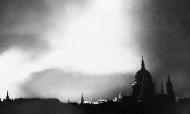
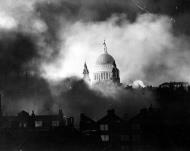




































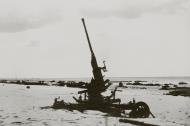

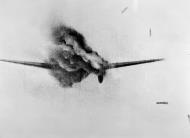


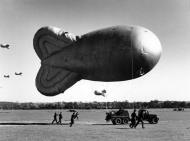
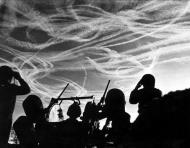
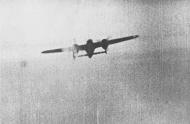
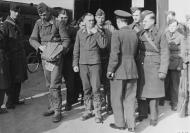
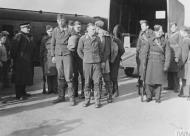
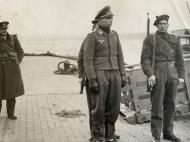
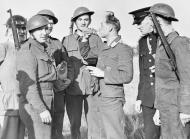
-radar-installation-at-Poling-Sussex-1945-IWM-CH-15173.jpg)
